Why does a virtuous man take delight in landscapes? It is for these reasons: that in a rustic retreat he may nourish his nature; that amid the carefree play of streams and rocks, he may find satisfaction; that he may constantly meet, in the country, fishermen, woodcutters and hermits; and that he may see the soaring of cranes and hear the chattering of monkeys. The din of the dusty world and the close confinement of mortal habitations are what human nature habitually abhors; whereas, on the other hand, haze, mist and the haunting spirits of the mountains are what human nature seeks, and yet can rarely find.
The Three Chinese characters above mean "A Treatise on Landscape," and the translation that follows is an excerpt from an essay on this subject by the great Sung landscape painter, Kuo Hsi, who lived during the eleventh century. The peoples of the Far East have been, since time immemorial, the world's greatest lovers of nature and of scenery. They developed landscape painting to a high level; and it was only after the Polos visited Cathay in the late thirteenth century, that landscapes began to appear in European painting, reaching a peak in the work of the sixteenth-century Flemish master, Pieter Bruegel. Influence from another branch of Chinese art having to do with landscape began to be felt in the Western Hemisphere a century later: this was the natural garden.
Traditional gardening in Europe had evolved from early times through the Middle Ages and Renaissance along geometric lines. The apex of this type of landscaping was attained in the great formal layout surrounding the Palace of Versailles. Here broad terraces, with basins and fountains, balustrades, staircases, flowering parterres, and long, tree-lined avenues affording distant vistas were planned by the designer Le Nôtre to accord with the architecture of the tremendous Baroque edifice. The principle involved was imposing an artificial scheme upon nature, in which rocks were crushed into gravel for the acres of flat paving adjoining the palace, and extending into walks beyond, water was arrested in shallow stone-framed pools to mirror the features of the building, or made to perform amusing acrobatics in jets among the sculptured lagoons, and trees, shrubs and hedges were clipped into square and distorted shapes contradictory to their innate forms. Opposition to this contrived treatment of European gardens arose and flourished in England, and isolated examples constructed on the continent came to be referred to as jardins anglo-chinois, the linkage indicating their immediate and derived sources of inspiration.
The natural garden was a symbol of the rising desire for freedom from staid European customs and concepts, taking its cues from the Chinese. As the ideas of Confucius on social manners, of Fu Hsi on mystical guidance, and of Lao Tse on deep metaphysical insight filtered into the West, the realization gradually dawned that existing society was far from ideal structurally, that materialistic philosophy was exceedingly limited, and that blind submission to revealed religion was intellectual slavery, and human beings individually and collectively could function better through relying upon pure reason, understanding and compassion. The time was not yet ripe in the seventeenth century (nor the means available) for a general turnover in the arts come from Eastern guidance -- this transpired much later: in Impressionist painting, in Art Nouveau decorative arts, and in the bungalow movement in architecture -- but the one exception was gardening. Admittedly, the first efforts at breaking away from the rigid framework of conventional European gardening was for exotic effects (the outdoor counterpart to the bizarre phase of the contemporary Rococo interior style known as chinoiserie), whereas, as the newness wore off, the natural garden gradually took on a high seriousness and became the accepted English park. Although certain early eighteenth-century British nationalists, such as Alexander Pope, chose to give credit for their aesthetic motivation exclusively to Nature, the fact remains that the impetus originally came from China. Certainly this was fully realized by Sir William Chambers, who himself visited the Middle Kingdom during the 1740's, published a book on Designs of Chinese Buildings, Furniture, etc., including a Description of Their . . . Gardens, in 1757, and within a decade became architect to the Prince of Wales, in which capacity he designed and built a series of structures in Far Eastern style at Kew Gardens near London. Among these was the impressive octagonal Chinese Pagoda, that soared 163 feet above the meadows and woodlands of the famous public park on the Thames.
 |
| Tower Near Canton, China. (Chambers, Designs of Chinese Buildings, London, 1757, Pl. V) |
A seven-storied tower copied verbatim from Plate Five in Chamber's Designs of Chinese Buildings appeared in the Pagoda and Labyrinth Garden opened in Philadelphia in 1827, the work of the architect John Haviland. It is significant that this early pleasure ground in the United States thus should have paid tribute to the Chinese via an English publication. American natural landscaped precincts of the next few years were for more melancholy usage: Mount Auburn Cemetery at Boston was completed in 1831, and Greenwood Cemetery, Brooklyn, was available for burials beginning in 1842. Pavilions in the Chinese mode hardly could be expected in such parks for the deceased; the gateway to Mount Auburn was in the appropriate sepulchral style of ancient Egypt, and that of Greenwood in orthodox Gothic Revival. This was the real beginning of the parting of the ways between the natural garden and Chinese-style architectural accessories. Nevertheless, we shall find that an oriental flavor persists in most park pavilions and that a few kiosks bear recognizable characteristics of specific Eastern prototypes.
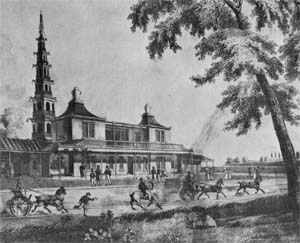 |
| The Pagoda and Labyrinth Garden, Philadelphia. Lithograph by B. Ridgeway Evans. (Historical Society of Pennsylvania) |
Toward the middle of the nineteenth century, a new concept came into being with regard to what constituted a public park in America. Earlier examples, such as the Pagoda and Labyrinth Garden in Philadelphia, were public in the sense that schools, libraries and museums of that period were public -- meaning they were available to everyone without discrimination, for the payment of a specified fee -- whereas subsequent parks were to be constructed and maintained at community expense for the use and recreation of all citizens gratis. The outstanding project was for park-destitute New York City, where a solid front of row buildings was expanding uptown, taking over block after block, at an alarming rate. The need for a large public park in the metropolis bad been suggested in 1848 by the foremost authority on landscape gardening in America, Andrew Jackson Downing (1815-52). As Editor of the periodical entitled the Horticulturist, Downing followed up his original suggestion with an article in the August 1851 issue, countering a movement to purchase a 150-acre tract along the East River extending from 64th to 75th Street, and urging that the park be made to contain at least 500 acres and be located in the middle of Manhattan Island, somewhere "between Thirty-ninth street and the Harlem River." He described many of the advantages and features that eventually were to be realized in Central Park. Soon afterward a committee appointed by the city aldermen selected the present site, but funds were held up because of factional rivalry, corruption in local politics and bureaucratic inertia, and six years elapsed before the land was acquired and work begun.
In 1857, the City owned about 770 acres between Fifth and Eighth avenues, from 59th to 106th Street (within the next five years to be extended to 110th Street), sparsely settled by squatters, and supporting such unsavory enterprises as slaughterhouses and associated glue works. The City employed some 500 laborers under the direction of the Chief Engineer, Egbert L. Viele, and a rather nebulous plan was being followed in the attempt to convert a dismal and barren region with outcroppings of jagged rocks into a verdant retreat. This situation looked rather hopeless when Frederick Law Olmsted, who bad been a successful scientific farmer, a topographical engineer, and had an inherent interest in landscaping, applied for the position of Superintendent. After some vicissitudes he was given the assignment, mostly because the name of Washington Irving (an invited consultant to the Board of Commissioners of Central Park) appeared among his papers. Olmsted's duties were to act as executive officer for the Engineer with respect to the laborers, and to have charge of the police force in the park. Obviously his powers respecting the design were limited.
 |
| First study of design for the Central Park. Woodcut, after Olmsted and Vaux's Greensward plan, 1858. (Description of a Plan for the Improvement of the Central Park, New York, 1868) |
Early in 1858 the Board of Commissioners launched a competition for an articulated plan for improving Central Park, offering premiums of $2,000, $1,000, $750 and $500 for the first four prizes. Calvert Vaux, a British architect, who had come to the United States in 1850 to work with Downing, proposed to Olmsted that they collaborate on a design. Olmsted at first refused on the basis that it would be showing insubordination to his superior, but when he learned that Viele did not care, he accepted. Their entry, entered anonymously under the name Greensward, was the last of 34 designs to reach the judges. It was awarded first place on 28 April 1858. During the following month Olmsted was given the title Architect-in-Chief of Central Park, and Vaux was appointed Consulting Architect.
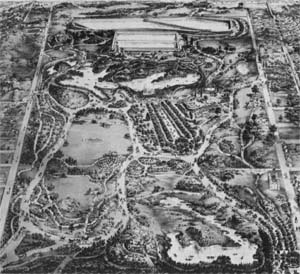 |
| Panorama of Central Park. Lithograph by John Bachmann, 1868. (Museum of the City of New York) |
The precinct was rectangular, measuring 1/2 mile east to west and about 2 1/2 miles north to south. In the exact middle was a rectangular reservoir about a third of the width of the park and extending on a latitude with 79th to 86th Street. Directly above it was a much larger irregular new reservoir, that spanned four-fifths the breadth of the park, leaving only narrow passages to either side. Provision had to be made for commercial traffic crosswise through the tract, which problem was solved by the introduction of four transverse roads, that were sunken, and the drives above furnished with overpasses thickly planted to conceal the lower roadways. The northernmost transverse road skirted the upper tip of the new reservoir. The second ran between the new and old, and the third crossed immediately to the south. The largest uninterrupted section of the park interlay the third and fourth transverse roads, roughly between 65th and 79th streets. Just east of an imaginary center line here and running obliquely was a formal promenade called the Mall. Its northern extremity was the Plaza, where monumental stairs descended to the Terrace featuring the Bethesda Fountain. Central Lake and the hilly Ramble were beyond. The Mall was oriented toward Vista Rock, the focal point of the park and on which stood a wooden lookout, replaced in 1869 by the small stone Romanesque-manner castle called the Belvedere. The open field west of the Mall was originally called the Parade Ground, and by the late 1860's had become known as the Green. Containing about 15 acres, this was the largest meadow in Central Park until the old reservoir was emptied in 1929 and made into the Great Lawn in 1935. The Mineral Spring Pavilion, near Eighth Avenue and 70th Street, and the hexagonal Music Stand, on the Mall near the Plaza, had cusped arches supported on slender colonnettes, and flaring, complex roofs, reminiscent of Saracenic architecture. Below the fourth transverse road were the Play Ground to the west and the Pond in the southeast corner. Facing the Pond, and accessible to the south transverse road for supplies, stood the Dairy, a stone and wooden gothic chalet designed by Vaux. Its porch was hit by a truck and subsequently removed about 1950. A preexisting building, still intact, is the Arsenal, at Fifth Avenue and 64th Street, erected in 1847, converted into the Museum of Natural History about 1870, and remodeled for Department of Parks offices in 1923. The main entrance to Central Park is at the intersection of Fifth Avenue and 59th Street, originally planned with a small plaza. The other three corners were indented by circles in the 1860's. The various parts of the layout were woven together by freeflowing drives and bridle paths, meandering walks shaded by clumps of trees, providing scale in opposition to the open grasslands beyond, and leading to picturesque wooded promontories, such as the Ramble. The creation of a landscape garden in the middle of the nineteenth century is related to the taste for landscape paintings of the same period, exemplified in the work of the Hudson River School of artists, composed of such men as Thomas Doughty, Thomas Cole, Asher B. Durand, George Inness, Frederick E. Church, and the Hart brothers, James M. and William. Olmsted's park meadows are equivalents to canvases by Inness, and his rambles to those of Durand.
Across the East River from New York City sprawled another great metropolis, Brooklyn. In the late 1850's, Manhattan was linked to Long Island only by ferries, and the independent City of Brooklyn had the third largest population in the United States. A movement was afoot in Brooklyn to make a sizable public park, similar to that in its sister city, and also a number of satellite parks. At the solicitation of the citizens, the Legislature of the State of New York passed an act on 18 April 1859: "To Authorize, the Selection and Location of Certain Grounds for Public Parks, and also for a Parade Ground for the City of Biooklyn." Fifteen commissioners were appointed to choose suitable sites, and on 3 February 1860 they submitted their recommendations. These included four major reserves: one was in Brooklyn proper, the second at Ridgewood, the third at Bay Ridge, and the fourth at New Lots. Three small local parks also were mentioned, one being a block on Brooklyn Heights bounded by Remsen, Furman and Montague streets, and Montague Terrace, to be set aside because of its superlative view of the harbor.
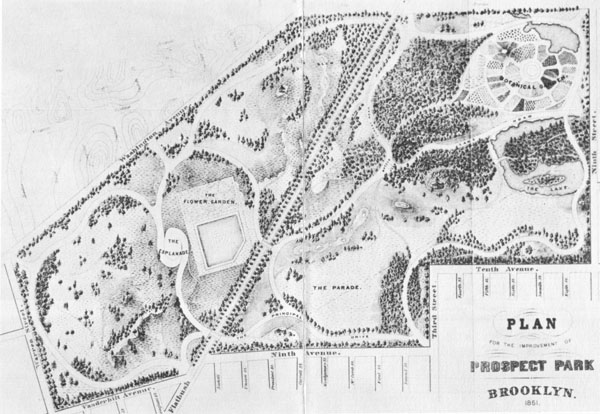 |
| Viele's plan for Prospect Park, 1861. (Annual Reports of the Brooklyn Park Commissioners) |
The largest and by far the most important of the seven proposals was referred to as Mount Prospect Park. Its name came from the bill on which the reservoir was located, near the intersection of Flatbush Avenue and present Eastern Parkway. The commissioners stressed that it was expedient for the purity of the water to retain undeveloped ground around the reservoir; and, as with the recommendation for the small park on Brooklyn Heights, they made a case for the vista from Prospect Hill, which overlooked the eastern part of Kings County, Brooklyn, Jamaica Bay, New York, the harbor, the New Jersey shore, and the Narrows and adjoining slope of Staten Island. The park was to consist of 320 acres, bounded by Washington Avenue from Warren to Montgomery streets, then following the Flatbush township line south-southwesterly to a point now in Prospect Park about equidistant from the three sites of the Nethermead Arches, and Lullwater and Terrace bridges, then west-northwest along 9th Street to Tenth Avenue (approximately the site of the Tennis House), then along Tenth Avenue to 3rd Street (northeast corner of the Litchfield Villa lot), then over to Ninth Avenue (Prospect Park West), then north-northeast to Flatbush Avenue, a short distance along this thoroughfare (crossing what is currently Grand Army Plaza) to Vanderbilt Avenue, four blocks north to Warren Street, and back to the beginning at its intersection with Washington Avenue. The area designated took in most of the present grounds of the Brooklyn Botanic Garden, all of the Museum, Library and old reservoir, and almost as much land lying due north, plus about two-fifths of the final Prospect Park precinct. The committee justified the economics of the park venture with the argument that the increased value of real estate in the vicinity would bring in greater tax returns to counterbalance the expenditure. They buttressed it with the humanitarian appeal that: "The intense activity and the destructive excitement of business life as here conducted, imperatively demands these public places for exercise and recreation"; and they noted that, although not centrally located in Brooklyn, Mount Prospect Park would be easily accessible "to the masses of our people," either "on foot or the cheap railroad lines."
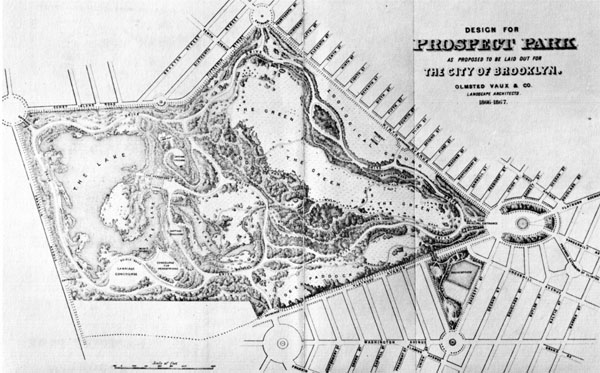 |
| Olmsted and Vaux's plan for Prospct Park, 1861. (Annual Reports of the Brooklyn Park Commissioners) |
Located within both the first and final proposals for the park area is the site of the easternmost encounter of the Battle of Long Island of the American Revolution, on the east side near the old Brooklyn-Flatbush line. Here stood the great white oak, that had been cited by Governor Dongan as a marker on the boundary between the two townships, felled as a barrier across the narrow lane to impede the British. Many other trees had been cut to make rude fortifications along the summit of the wooded ridge above Valley Grove Pass, as colonial forces under General Sullivan lay in wait for the enemy's advance on the fateful morning of 27 August 1776. They were greatly outnumbered; and, after their first volley had been fired and there was not time for reloading, a rifle butt served as poor defense against pitiless Hessian bayonets in hand-to-hand fighting, with the result that the encounter turned into a massacre and rout on the part of the Americans. Later in the day, General Stirling sought the Hessians in Prospect Woods and yielded himself, rather than surrender to an English officer. The Maryland Monument, at the foot of Lookout Hill west of Terrace Bridge, and several bronze plaques north of the modern zoo commemorate the events. Having been an historic setting played an important, persuasive role throughout the lengthy process of the park becoming a reality.
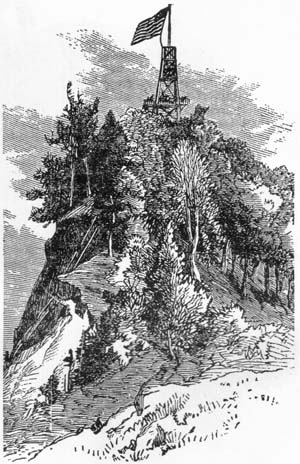 |
| Lookout Hill. Woodcut. (Tripp, A Hand Book for Prospect Park, New York, 1874) |
The State Legislature confirmed the recommendation by an act passed 17 April 1860, and through this document the right to acquire the designated land became law. Also, the officials of Brooklyn were empowered to issue bonds to cover the costs of the endeavor. A turnover in the roster of the Board of Commissioners occured during the year, with only one name surviving from those of the original fifteen selectees (that of Thomas G. Talmage), and the current seven members elected James S. T. Stranahan (1808-98) president, and R. H. Thompson secretary. In the person of the new President of the Board, Prospect Park gained its most ardent champion. Stranahan, who was a millionaire, served in this post without remuneration for 22 years and, upon leaving, he presented the City a check for $10,604.42 to cover a shortage claimed against the commission during his period of tenure.
The first expenditure of the commissioners was to hire a topographical engineer, which specialist was Egbert L. Viele, the original Chief Engineer for Central Park. Viele examined the premises and composed a written report, in which he indicated his conviction that "the primary object of the park [is] as a rural resort, where the people of all classes, escaping from the glare, and glitter, and turmoil of the city, might find relief for the mind, and physical recreation." The city grinds down its dwellers, he says: "while on the other hand nature in its beauty and variety never palls upon the senses! never fails to elicit our admiration; whether displaying its wild grandeur in the vast solitudes of the forest, . . . whether bursting the fast of winter, it opens its buds in spring-time, or yielding to the chilling blasts it scatters its autumn leaves -- it conveys in all its phases and through all its changes no emotions which are not in harmony with the highest refinement of the soul." The tone of this prose poem, by a nineteenth century American, is not unlike that of the eleventh century Chinese, quoted at the beginning. Kuo Hsi recommended, as a substitute for direct communion with nature, a "landscape painted by a skilled hand." Viele exhorts the natural garden, which to "the weary toiler . . . supplies a void in his existence and sets in operation the purest and most ennobling of external influences." It was a great and wonderful philosophy of compensation transposed into modern terms and means.
Viele calls his design of 1861 Plan for the Improvement of Prospect Park, eliminating once and for all the "Mount" in the title. He locates the main entrance at the junction of Flatbush and Vanderbilt avenues. Other entrances in the east section are at the corner of Warren Street and Washington Avenue, and midway along Washington Avenue. Entrances to the west section are at each of the lower corners, and another where 3rd Street and Ninth Avenue meet. The driveways wind through the grounds without definite direction, ascending to a climax on the Esplanade atop Mount Prospect, where carriages might pause 200 feet above sea level to allow their passengers to enjoy the spectacle. A flower garden, with meandering paths, adjoins the water-supply basin. The roads cross over Flatbush Avenue on viaducts at two places, one near the main entrance and the other by the reservoir, and under it by means of a tunnel at the south end. In the lowest corner, on 9th Street, is a botanical garden with intersecting radial and concentric curved walks. A small horseshoe shaped lake is indicated to the west, about where Swan Boat Lake later materialized. The chief meadow is between 3rd Street and Flatbush Avenue, anticipating the northern end of Long Meadow. Viele labeled this feature "The Parade," ignoring the previously published statement of the commissioners that they deemed it unsuitable to have a drill field inside a park of this species. The report concludes with technical data on drainage, manuring, trenching, planting, and building cracked-rock roads, as these were applicable to the situation. The work of conversion was estimated to cost $300,000, the largest item, $75,000, allocated for roads.
The outbreak of the Civil War in 1861 paralyzed the Prospect Park project, just as it did many other contemporary endeavors in America. At least in this instance the delay proved to be a blessing in disguise, allowing time for reflection and determination. In the brief report of the commissioners made in January 1862, Stranahan declared that "Prospect Park in the city of Brooklyn must always be conceded as the great natural park of the country." The one constructive task that moved forward during the interim was making estimates of private properties designated within the scheme; and, because of the easing of the real estate market due to the lack of security accompanying the conflict, it was recognized as "a peculiarly favorable period for making payment to the landlords." The report three years later stated that compensation would amount to $1,357,606, and that remittances already were in progress. Decent houses thus acquired were to be rented until the ground they stood on was ready to be improved for the park, whereas shanties and their squatter tenants were "being quietly removed." A very important item in this report was the appendix, involving a reconsideration of the boundaries by an expert engaged for the purpose.
The survey had been put into the capable hands of Calvert Vaux (1824-95), the British architect who joined forces with Andrew Jackson Downing in 1850 and worked on the landscaping of the Smithsonian Institution and part of the Capitol grounds in Washington prior to Downing's drowning in the sinking of the steamboat Henry Clay two years afterward. To his late friend and associate Vaux dedicated a collection of his own architectural designs brought together in a book entitled Villas and Cottages, published in 1857. As we have seen, the following year Vaux collaborated with Olmsted on the plan that won the competition for Central Park and was appointed Consulting Architect. The next eight years of experience in the Manhattan park well qualified him for giving sound advice on Prospect. Calvert Vaux did not approve of the tract being divided by Flatbush Avenue. The overpasses were awkward and an expense that could be applied to better advantage purchasing additional contiguous land. He favored concentrating on and extending the western section, because the reservoir, in the other division, could not be landscaped attractively. Yet he felt it would make a worthwhile supplement to the park, because of its elevated promenade. The primary deficiency in the existing grounds was a place suitable for a large lake, which would be a valuable asset, especially because ice skating on it would prolong the usefulness of the park into the winter. He complained that the land dug in Central Park was too small and estimated that the lowland north of Franklin (Parkside) Avenue in Brooklyn could accommodate an articial body of water 50 or 60 acres. This would require a vast annex to the south, in Flatbush; but "the amount relized for the sale of the north-easterly section would go far to defray the cost of the proposed addition, if it would not pay for it entirely." Another feature established at this time was that the principal entrance ot the park would "unquestionably be near the point where Flatbush . . . is intersected by . . . Ninth avenue." An accompanying sketch plan, dated 4 February 1865, indicates an elliptical plaza at the north end, the shape, size and location of which accord with what exists there today.
The preliminary report on boundaries led, later in 1865, to the reengagement of Vaux, together with his partner Olmsted, to create a whole new plan. Of the two men, Frederick Law Olmsted (1822-1903) was the better informed on growing plants and landscaping in general. Olmsted was a native American, born in Hartford, Connecticut, and he had learned the rudiments of rural skills as a little boy visiting relatives in the country. Later, at home, he frequented the Harford Public Library, perusing such books as Sir Uvedales Prince's An Essay on the Picturesque and William Gilpin's Remarks on Forest Scenery, both published at London in the early 1790's. At fourteen Olmsted apprenticed to a topographical engineer and learned surveying; at twenty-one he became a seaman and shipped aboard the Ronaldson to Hong Kong; at twenty-five he finished a course at Yale and took up scientific farming, first at Gilford and then on Staten Island, where he spent much of his time in landscaping and yet was successful as a farmer. He was thirty-five when he assumed the role of Superintendent in Central Park, and the next year he devised the Greensward plan with Vaux, who was two years his junior. Olmsted had been in California in 1865, when the survey was requested, and that Calvert Vaux had made it alone indicates that both men were proficient at landscape gardening, but, generally, Olmsted is considered the genius in composing scenery and Vaux in planning architectural accents.
The plan for Prospect Park conceived by Olmsted and Vaux in 1866 was accompanied by a lengthy essay, which the Board summarized for the Brooklyn Common Council as follows:
The ground features of the plan are simple and easily comprehended; but the Commissioners wish to direct attention particularly to three regions of distinct character embodied in it, in each of which, it will be observed, the suggestions of the natural condition of the land are proposed to be developed. They are, first, a region of open meadow, with large trees singly and in groups; second, a hilly district, with groves and shrubbery; and third, a lake district, containing a fine sheet of water, with picturesque shores and islands. These being the landscape characteristics, the first gives room for extensive play grounds, the second offers shaded rambles and broad views, and the third presents good opportunities for skating and rowing.
Besides these, there are minor intermediate and exterior portions of the grounds which are devoted to zoological gardens and other special purposes. The different parts are connected with each other, and are brought advantageously into use and under observation by a carefully adjusted system of rides, drives and rambles. The existing natural features of the charming locality are everywhere accepted and made available, and the artificial constructions necessary for the convenient accommodation of the public, are as inconspicuous and inexpensive as possible, consistently with permanency and good taste.
The Commissioners are satisfied that the plan now submitted ought not to be changed in any manner . . . and that it cannot again be altered without serious disadvantage.
With this thumbnail description in mind, let us look at the plan itself. First of all, the landmark that had given title to the park, Prospect Hill, was outside the confines. In outline and paramount features, the design is the archetype of the garden that was eventually objectified. The irregular shape is six-sided, coming to a point at the north extremity on an oval plaza. The northeast side is bounded by a stretch of Flatbush Avenue; the east limit steps in and continues almost directly south along what is now
Ocean Avenue. The southeast base is Franklin (Parkside) Avenue, ending at present Park Circle, foyer to the southernmost entrance. The southwest side is framed by Coney Island Road (Prospect Park Southwest), which curves into 15th Street. This meets Ninth Avenue (Prospect Park West) at right angles, the intersection embellished by another circle (Bartel-Pritchard). Ninth Avenue or Prospect Park West returns us to the place of beginning. Of the seven drive entrances, all but one are at or near one of the corners of the configuration, the exception being on the upper west side at 3rd Street. It is of interest that only one other has been added, that on Ocean Avenue, and it is without elaboration. An element not to be realized is the overpass crossing Flatbush Avenue to the reservoir lot. The report proposes a Parade Ground across Franklin (Parkside) Avenue, although it is not indicated on the map. The park proper contains 526 1/4 acres. Its compact, arrowhead shape is more appropriate to a natural-landscape garden than the elongated regular rectangle of Central Park, in which one is always conscious of the surrounding city. The final limits of the Brooklyn precinct had been chosen by the landscape architects themselves, and the area was not encumbered by reservoirs, neither did it require division by transverse roads. The boundaries enclosed less land but the space could be put to more effective use, as in the case of the tremendous sweep of meadow nowhere possible in the New York park. It was attained with less labor because the western end of Long Island had escaped the glacial upheavals and was free of the harsh protrusions of jagged rock found on Manhattan. A brilliant innovation in the Brooklyn park is the ridge of heavily planted earth just inside the walls, that makes an effective screen blocking out the urban scene and permitting an instant illusion of being in the country.
A glance at the 1866 Olmsted-Vaux plan for Prospect Park and comparison with the contemporary scheme for Central show what a tremendous simplification and unification has been achieved in the Brooklyn design. The three elements mentioned in the commissioner's summary roughly dispose themselves into approximately equal thirds of the park. The open meadow occupies a long strip adjacent to the northwest boundary on Ninth Avenue. Thrice labeled here "The Green," after 1870 it became known as Long Meadow. Beginning inside the principal entrance on the Plaza, the crescent-shaped lawn, covering 75 acres curves toward the center of the park and out again to the entrance at 15th Street and Ninth Avenue (Bartel-Pritchard Circle). The West Drive winds through the trees framing the concave side of the crescent. Wooded hills, constituting the second element, occupy the region running through Prospect Park east of Long Meadow. It is a very irregular and varied section, taking on almost the character of a mountain defile in the stretch north of the Nethermead, between the Green and East Drive, and that of a stony valley with a brook in the Ravine extending from the Lily Pond above the Lullwater to Swan Boat Lake. The source of water is an artificial spring immediately to the south, at the base of Quaker Hill. The ground rises steadily to the summit of adjoining Lookout Hill, the highest prominence in the park, at the head of the peninsula jutting out into the Lake. Woods, or at least arrangements of trees, border other features of the park and weave them all together into a coherent whole. The third element is the Lake or, more generally, water, of which the 60-acre lake is the most conspicuous member; included are the narrow lagoons leading to the Lullwater, the stream in the Ravine with its assorted pools, and the spring that feeds the entire system. The Lake overspreads most of the south triangle of the reserve and its tributary reaches far inland. We have here the constituents of the Chinese landscape, as may be seen in any painting of scenery done in the Far East. The Chinese term for "landscape" is composed of two words, shan and shui. The first means "hill" and the second "water." The characters for these words appear at the beginning of this essay, as the heading for the translation for the Kuo Hsi quotation, the third character in the title being hsun, "treatise."
The drives meander inside the perimeter of Prospect Park, encompass the Lake, Lullwater and Lily Pond, and traverse the woods from Willink Entrance on Flatbush Avenue over Breeze Hill and around the Nethermead, between Lookout Hill and Quaker Hill, to the 16th Street Entrance on Coney Island Road (Prospect Park Southwest). Walks and bridle paths (referred to in early accounts as "rides") tend to follow the contours of the drives, but these also branch out considerably more, enmeshing many parts not accessible to the drives. The carriage roads were of crushed rock and had an average width of 40 feet, increasing to 60 at the principal entrance. A narrow roadway ascends Lookout Hill to the paved plateau on top, described as "an oval court for carriages, three hundred feet long and one hundred and fifty wide." A terraced platform adjacent was to be provided with seats and awnings, and a small building "for the special accommodation of women and children, and at which they might obtain some simple refreshment." An elaborate Eclectic stone tower was to have been built here too, affording an even better vista of the bays and surrounding lands to the west, and a bird's-eye view of demonstrations on the Parade Ground to the south. A second, and larger, concourse for carriages was to the east of the Lake, and next to it was a space labeled "Concourse for Pedestrians," a promenade that developed in 1870 and will be discussed below. Due west, on what came to be called Breeze Hill, was a lesser stopping place for carriages, permitting a panorama over the inlet of the Lake. Midway between here and the Lookout, at the head of the inlet north of the Peninsula, was to have been built the Refectory, with broad arched terraces overlooking the water. The name of Terrace Bridge close by recalls the project which, like the proposed structures on Lookout Hill, expired before realization. The Refectory was to have been the "principal architectural feature in the park," like a well-appointed inn in the country. Even though other minor aspects changed on maps issued within the next few years, the Refectory and Lookout persisted as long as Olmsted and Vaux had anything to do with the park. Afterward, when nothing came of the restaurant, Well House Drive was laid out from Terrace Bridge around the corner of the shore to West Lake Drive.
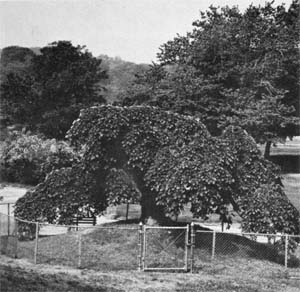 |
| The Camperdown Elm. Photograph, 1967. |
The upper reaches of the park were to present "a display of the finest American forest trees." Among native deciduous varieties in Prospect Park are to be found: American elm, the oaks and maples, yellow poplar or tulip tree, ash, red mulberry, wild cherry, dogwood, Kentucky coffee tree, sassafras and Osage orange. American conifers include the white pine, blue spruce, hemlock, and the bald cypress from southern swamps. On "the interior slopes of the Lookout and Friends' Hill" there was to be "a collection, arranged in the natural way, of the most delicate shrubs and trees, especially evergreens, both coniferous and of the class denominated in England American plants, such as Rhododendrons, Kalmias, Azaleas and Andromedas." The shore of the Lake was to be planted in "picturesque groups of evergreen and deciduous trees." From the beginning, many plants were introduced into the park from other parts of the world, some of them constituting gifts. Among the trees from Europe were: the sycamore maple (the leaf of which was taken over as the emblem of the Department of Parks), Norway maple, European lindens, English oak, English elm, Scotch elm, English hedge maple, European beech, European hornbeam, horse chestnut, and Austrian pine. The single most noteworthy example is the Camperdown elm near Cleft Ridge Span, a Scotch elm grafted on a normal elm and prized for its contorted horizontal branches. Set out in 1872, it was already considered a landmark when Louis Harman Peet published Trees and Shrubs of Prospect Park in 1902. Asian trees include the scholar or pagoda tree, ginkgo, tree of heaven, Chinese elm, Chinese tree lilac and magnolia. Among oriental evergreens are the Himalayan pine, Japanese Tanyosho pine or umbrella pine, and oriental spruce. A tree-moving machine was devised in 1867, enabling a good-sized specimen to be taken up, together with a large portion of soil around its roots, braced, and wheeled upright to be put into the earth at a different location. Numerous trees standing in Long Meadow were removed and placed elsewhere by this device. In 1872 there were 284 trees thus transplanted. The park maintained its own nursery, in which an average of 30,000 trees and 25,000 other plants were kept on hand, and during the first two years of building Prospect Park, over 73,000 trees and shrubs were set out from this stock.
After considering trees, a word regarding the survival of wild life in this area should be in order. Of greatest importance are the birds. These little winged creatures need two simple requirements, cover and sustenance. Trees and other plants just discussed fill these needs and therefore attract the birds. Migrants are semi-annual visitors to Prospect Park, first lighting on Lookout Hill and following the ridge northward and then eastward, crossing Quaker Hill to the Pools and threading their way throught the Ravine, and leaving the park either at the Vale or Lily Pond. At one time there were numerous birds on the Peninsula, but the removal of the shrubbery and clamour from the skating rink opposite, in season, have ended their sojourn here. At the eastern end of the Ravine is an established community -- bullfrogs, who sometimes supply impromptu entr'actes during the Goldman concerts in the Music Grove on warm summer evenings. The other notable subhuman societies are the squirrels in the trees and the fishes and crustaceans in Prospect Lake.
The presentation of the Report of Olmsted, Vaux and Company in January 1866 was the official birth certificate of Prospect Park. The plan was printed and distributed among the citizens of Brooklyn and, although there were a few die-hards who clung to the retention of the eastern sector, on the whole they responded with "a hearty approval of the design," and "no material objection was made to any of its prominent features." Frederick Law Olmsted and Calvert Vaux officially were made Landscape Architects of Prospect Park on May 29th and given complete responsibility for everything that was to transpire in the venture. They were asked to prepare details of their plan and to organize a working force. The Board appointed Joseph P. Davis engineer in charge, and John Bogart and John Y. Culyer his principal assistants. The surname of the last caused some confusion in the appearance of Vaux's given name in print, sometimes coming out as a hybrid between Calvert and Culyer. The typographical error most appropriate to a landscape architect was "Culvert."
The Legislature of the State of New York passed an act on 30 April 1866 sanctioning the change in land designation. An interesting problem arose over the Quaker Cemetery, located between Eleventh and Twelfth avenues and 9th and 14th streets, completely enveloped by the recent acquisition. The matter was discussed at length and finally settled by the Friends' retaining the southern two-fifths of the lot, or that portion interlaying 11th and 14th streets, to which they were assured direct passage through the reserve from the 16th Street entrance at all times. The ten-acre cemetery is still being used for burials but, as Quakers do not approve of ostentatious memorials or markers except for the fence enclosing it, one is hardly conscious of there being a graveyard in the park.
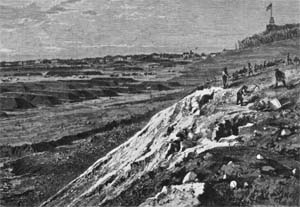 |
| The Lake under construction, view from Breeze Hill. Woodcut, 1868. (Annual Reports) |
The first task preparatory to building Prospect Park was draining the land wherever necessary. Then construction began at the upper terminus. The processes involved were tearing down unwanted structures and removing the debris from the site, putting in drain and sewer lines, grading, building roads, bridle paths and walks, taking up trees and putting them elsewhere, and setting out new plants. These activities gradually proceeded southward along the east side of the park. The manual labor started in June 1866 with a crew of 300 men. Although declining during the winter months, the number of employees increased to a peak in October 1867, when 1,825 were on the payroll. After this, there was a leveling off, with an average of about 1,100 in the warm months of 1868, close to 1,000 in 1869, 750 in 1870, back up to 1,100 in 1871, and than a gradual reduction to about half this number in the depression year of 1873.
Visitors to the park were a nuisance to the work crews during the construction period. Especially after the upper reaches of Long Meadow and the Woods were done and the scene of activities was the southern half of the reserve, people came in droves and destroyed much of the early planting through tramping on it. An average of 100,000 persons visited the park monthly during the summer of 1868, and by 1871 the count had increased to 250,000. But it was understood that the park is for people; and, for their use and enjoyment, benches of wood slats on iron framework were provided as soon as possible. Over 200 were installed in 1868, half of them 7 feet in length and the others 5 or 4 feet long.
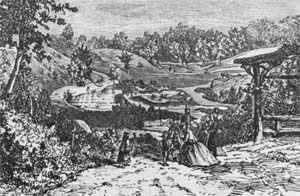 |
| The Playground and Pool from the Rustic Arbor. Woodcut. (Tripp, A Hand Book for Prospect Park, New York, 1874) |
The most appropriate structures in Prospect Park, for tying in with the landscape, were the rustic shelters, those with posts and lattice railing of rough tree trunks, and shingled or thatched roofs. These were of various oblong and polygonal shapes. Four were spaced along the east shore of the Lake, of which only one survives, the rectangular, hipped-roof Landing Shelter near the Carriage Concourse. These were viewing stations for western sunsets over the water. A five-sided rustic shelter stood on the spur at the south end of the Lake, nearest Park Circle, and an octagonal example stood on a high point in the Ravine, overlooking the bridle path spanned by Boulder Arch. A rustic arbor 111 feet in length was on the east side of the Lake, and another shaded a portion of the walk north of the Children's Playground.
The Playground, developed in 1867, was provided with a lawn for various games, including croquet, a pool for the sailing of toy boats, a maze, and a heptagonal summer house. The first carousel was erected here in 1874. It was moved to Picnic Woods (west side of Long Meadow, back of Litchfield Villa) in 1885, and the Rose Garden was laid out in 1895 on the site of the Playground. The adjoining Vale of Cashmere bad just been renovated a year or two earlier, with additions of pedestals bearing urns, some connected by balustrades, and a fountain sculpture in the pool, making for a strange combination of rustic and classic elements. One other early building belonging to the rustic group was the picturesque Thatched Shelter, that stood midway between the second location of the carousel and Meadowport Arch. It had an H-plan and a steeply pitched roof pierced by dormers. The shelter also was called the "Swiss Thatched Cottage" and the "Indian Shelter." It burned in 1937. Several rustic bridges were in the park. A large one of 35 feet was the Binnen Bridge over the waterfall near the old boathouse on the Lullwater. Smaller examples were at the west end of the Ravine, lending a remote atmosphere. There were also more than 50 rustic seats of sassafras and cedar, and 800 rustic bird houses.
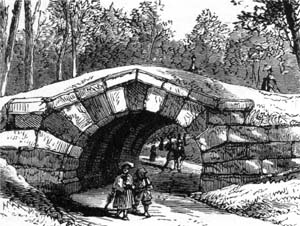 |
| East Wood Arch. Woodcut. (Tripp, A Hand Book for Prospect Park, New York, 1874) |
The first permanent structures were the arches on the upper and east sides of Prospect Park. These were pedestrian underpasses, allowing visitors to cross under the roads thus avoiding the hazards of traffic. The tunnels were provided with seats to serve a second function as comfortable rain shelters. The first two built were East Wood Arch under East Drive above the Willink Entrance approach, and Endale Arch near the entrance on the Plaza. The masonry of both is composed of alternating blocks of yellow Berea sandstone from Ohio and reddish brownstone from New Jersey, and the interior vaults are of brick lined with planks.
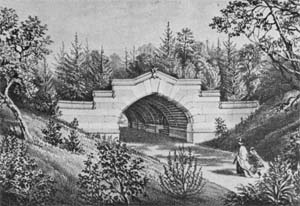 |
| Endale Arch. Lithograph, 1869. (Annual Reports) |
East Wood Arch is the simpler, with a low raking parapet above a semicircular arch, a single cross-vault inside with benches at each end in shallow recesses. Endale Arch -- sometimes referred to as Enterdale Arch in early reports -- has a stepped superstructure rising to a raked coping wth a carved flower at the apex, and a pointed arch. These features, together with the banded stonework in two colors, show Syrio-Egyptian influence. There are two cross-vaults, originally with benches in their recesses, in Endale Arch. Planting on top of the tunnels masks passing vehicles. Both tunnels were started in 1867 and completed the following year.
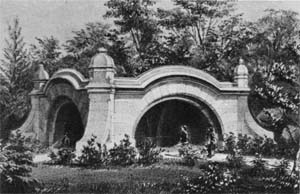 |
| Meadowport Arch. Lithograph, 1872. (Annual Reports) |
Meadowport Arch, balancing Endale on the west side of Long Meadow, was begun in 1868 and finished in 1870. Instead of cutting under the roadway perpendicularly, like its predecessor, it is set on a 45-degree angle. This permits a double portal at the lawn end, forming two faces of a square pavilion set diagonally into the embankment. A single bay of semicircular cross-vaulting is buttressed at the corners by piers that sweep outward at the base and are capped by octagonal bonnets with finials. The cornices arch in curves concentric to the extrados of the wide openings, a feature of seventeenth-century Mogul architecture in India, such as the Pearl Mosque in Delhi. The voussoirs alternate in smooth and rough-surfaced blocks of Ohio sandstone. A bench filled the recess facing the east arch but, as in the other examples, it has been removed. The northwest end of the wood-lined tunnel has a single face of similar design.
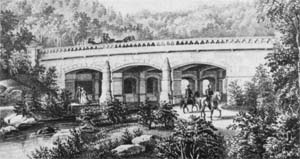 |
| Nethermead Arches. Lithograph, 1869. (Annual Reports) |
Contemporary with Meadowport Arch is Nethermead Arches, at about the geometric center of Prospect Park. Three segmental-arch spans, four bays deep, constitute a bridge for Central Drive. The three sections serve as underpasses for pedestrians, equestrians, and the Ravine brook between. Nethermead Arches was built of Ohio sandstone with Quincy granite trim. A plain molding constitutes a necking below the springing of the arches, and cylindrical buttresses on square plinths and with pinnacles are set in front of the piers. A parapet pierced by trefoils makes a railing for the upper carriageway and terminates in a monumental pedestal at each end. The inner vaults are faced with hard brick laid in patterns and open laterally into one another.
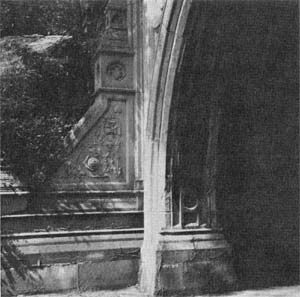 |
| Detail of Cleft Ridge span. Photograph, 1967. |
The last of the underpasses was built in 1871-72. Called Cleft Ridge Span, it is at the east end of Hill Drive, near the Camperdown Elm. Unlike the others, this tunnel is built of molded blocks of concrete, known as Beton Coignet, consisting of sand, gravel and Portland cement. Three colors are used, a brownstone red, ochre, and pale gray. The relief pattern of the sheathing inside the vault is rich and satisfying. The external design is eclectic and somewhat precious in detail. Buttresses flanking the round arches are accented with urns at base and summit, once containing plants. These have suffered from erosion and mutilation, especially on the south side of each facade. The French process provided a less expensive material than stone. Olmsted-Vaux plans of the late 1860's and early 1870's indicate that there were to have been additional pedestrian arches under or over the drives on the west side of the park, but only the ones described were built, all completed while the designers were still in charge.
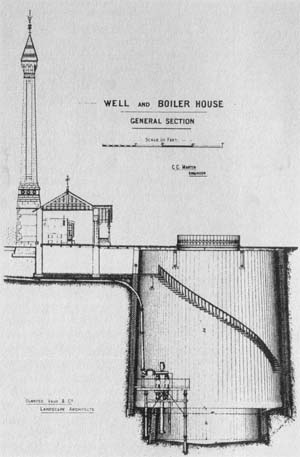 |
| Well and Boiler House. Engraving, 1870. (Annual Reports) |
Perhaps the most practical building in the park was the Well House, built in 1869 on the lake side at the foot of Lookout Hill. It is a rectangular building of banded croton brick and gray Ohio stone, with stone quoins and stone lintels over the windows and Tudor-arched doorway, and overhanging hipped roof. It housed the steam machinery and boiler, that were connected with the pumping engines 60 feet below grade. The engines could raise 750,000 gallons of water a day into the reservoir built into the west end of the hill.
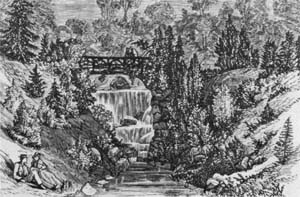 |
| Waterfall and Glen above Lullwater. Woodcut. (Tripp, A Hand Book for Prospect Park, New York, 1874) |
From here the water flowed out of a simulated spring at the base of Quaker Hill and down a gully into Swan Boat Lake, thence through the Ravine to the Lullwater and into the Lake. The source of water was a well 70 feet deep and 50 feet in diameter at the bottom, the walls battering in 10 feet at the top. It was in front of the boiler house, and a square smokestack 60 feet tall was attached to the rear corner. The digging of the Lake was accomplished in intervals. The last section was finished and filled with water 20 August 1871. The original use of the Well House came to a close with the advent of city water into the park about the turn of the century, after which the smokestack was torn down and the well covered over. Lookout Hill reservoir was filled in during the 1930's.
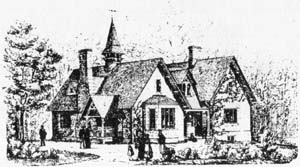 |
| View of the Dairy. Engraving, 1870. (Annual Reports) |
A building of all stone walls erected in 1869 was the Dairy and it was similar to its equivalent in Central Park. It stood in the Midwood, just north of Boulder Bridge over the bridle path. The Dairy was composed of two parallel wings having gables with bargeboards at each end in front, and a connecting unit with a dormer and cupola atop the steep roof. It contained a large public room and smaller ladies' retiring room, both with fireplaces, and facilities on the first floor. Quarters for a family in residence were upstairs. The Dairy supplied light refreshments, including milk, chilled or warm from the cow, because cattle, and sheep as well, were pastured on the Green. The old menagerie was built to the north and east of the Dairy after Olmsted and Vaux had left the scene of tho park. The entire group was razed following completion of the new zoo in 1935, the loss of the Dairy, at least, being regrettable.
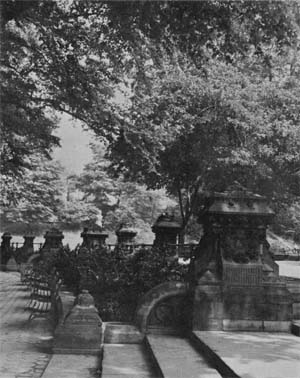 |
| Concert Grove, the Terrace. Photograph, 1967. |
It is significant that the small area in Prospect Park conceived along the formal lines of European gardens -- as opposed to the vast balance, which is in the natural Chinese-inspired, English-park mode -- although labeled "Concourse for Pedestrians," was otherwise left blank on the original plan of 1866. That it was intended as a haven for music is indicated by the words "Music Stand" alongside the small island off shore. The region referred to was elaborated in 1870. Olmsted and Vaux testified that they followed an Old-World precedent in their scheme here. "Promenade concerts are common in many European pleasure grounds," they said, and "may be divided into two classes: those universal in German towns, common in French, and less so in British, where the audience is standing, walking, or sitting upon chairs, and frequently at tables at which refreshments are served, and those in which the greater part of the audience is in carriages," as in Italy. They proposed to combine the two types in Prospect Park. The Pedestrian Concourse is situated between two carriage concourses. The latter take care of listeners preferring the Italian manner, whereas the former required renovation to accord with north-European tastes. The middle section was divided into two plateaus by a curved terrace concentric to the shore line and centered on the music stand on the islet. Trees were planted in uniform rows in the lower space; and beyond the stone piers and railings and stairs, on the upper terrace, there was laid out a fan-shaped system of walks radiating from the music source, with fountains at the intersections and a casual growth of trees in the interspaces. This henceforth was known as the Concert Grove. Sculptured likenesses of musicians were placed here, the group including busts of von Weber and Grieg on the east side, Mozart and Beethoven on the west, and that of Thomas Moore, poet, composer and concert pianist, in the center. The United German Singers of Brooklyn presented the images of their countrymen, won as competition prizes during the 1890's.
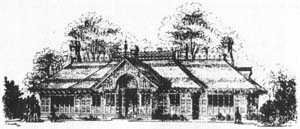 |
| The Concert Grove House. Engraving, 1872. (Annual Reports) |
At the farther end was built a typical Vaux chalet called the Concert Grove House. It resembled the contemporary Dairy, only it was frame instead of stone. The building housed a restaurant and comfort station.
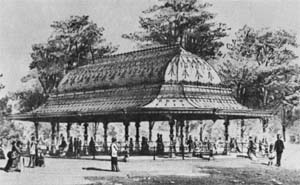 |
| Concert Grove Pavilion. Lithograph, 1873. (Annual Reports) |
Fifty feet to the south was erected a shelter called the Concert Grove Pavilion, completed in 1874. The Pavilion consists of eight cast-iron posts, modeled after Hindu columns of the early medieval period (8th-12th centuries), supporting a complex hipped roof with rounded corners, measuring 40 by 80 feet, having patterns on its surfaces and a cresting along the ridge. Tables and chairs were placed under this oriental parasol for service from the restaurant. Thus in providing a pleasant retreat for strolling, parking space for carriages, benches, and seats around refreshment tables, the concert compound met all the listening delights of the Europeans; and it went even further: the music was available to boating parties drifting on the Lake. In its formality and function, Concert Grove in Prospect Park is the counterpart of the Mall in Central Park. However, Concert Grove has none of the axial rigidity of the Mall. Instead of being elongated and dividing the park, it is compact, and its radial plan is dynamic, thereby being better suited to the natural landscape theme of the garden as a whole.
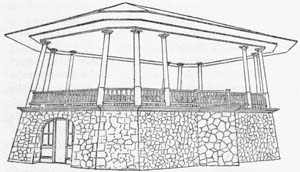 |
| Music Pagoda. Restored sketch. |
Apparently the acoustics around the insular Music Stand were satisfactory only over the water, and concerts soon moved out of the area. A temporary music pavilion was set up in the Lullwood in 1871, and the permanent Music Pagoda was built near the Lily Pond in 1887. This octagonal structure has a high battered podium of rough stonework, above which rise slender posts slanting inward and connecting with the flaring roof. The form suggests an ancient Chinese city gateway. With the establishment of the new Music Grove at the north edge of the Nethermead, its predecessor became known as the Flower Garden. Concert Grove House was demolished in 1949, and Concert Grove Pavilion later was vulgarized by the insertion of a brick snack bar in the middle. The skating rink built in 1960 obliterated Music Stand Island and a stretch of the shore.
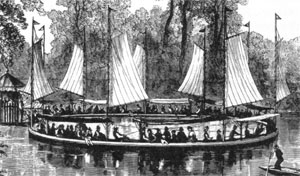 |
| The Circular Yacht. Sketch by Charles Menti. (Harper's Weekly, 27 July 1878). |
A curiosity dating from the Olmsted-Vaux period was a kiosk known as the Camera Obscura, situated at the west end of Breeze Hill. It provided -- as its name signifies -- a dark chamber, in which was a white table five feet in diameter. On the table was projected an image reflected from a revolving mirror-lens arrangement in the roof. The view necessarily was limited to the vicinity. The Old Fashioned Garden later occupied the site. Another oddity of the early era was the Circular Yacht, a sort of water carousel, propelled by sails and oars, that revolved without really going anywhere. As one would expect, the Circular Yacht was not prominently displayed on the Lake but set afloat on the Pool, eventually dammed and enlarged into Swan Boat Lake. Neither of the novelties survived into the twentieth century.
The cost of the park during the seven-year administration of Olmsted and Vaux was tremendous. The land alone had cost more than $4,000,000. Improvements amounted to upwards of $5,000,000, the equivalent of almost $25,000,000 in terms of the market value of the dollar today. Prospect Park was the largest single investment made by the City of Brooklyn up to that time, and it is unlikely that any, before or since, has reaped such high dividends in profits of intrinsic value.
Olmsted and Vaux's sway of influence went beyond the park confines to related axes and areas. That most closely connected with Prospect Park is the plaza at its main entrance. The elliptical plaza received encouragement in 1867 through the gift to the City of a bronze statue to be erected here. Modeled by the late Brooklyn sculptor, H. K. Brown, it was a standing likeness of Abraham Lincoln, nine feet tall. The figure wears a cape and holds a scroll of the Emancipation Proclamation, the right hand pointing to the words, "Shall Be Forever Free." Probably the first memorial to the assassinated president, it was the gift of the War Fund Committee of Kings County. Elevated on a 15-foot granite pedestal, it was placed on the platform at the north side of the Plaza. The Lincoln statue was dedicated 21 October 1869, and two years later a fountain was put into operation in the center of this open area.
The designers widened Vanderbilt and Ninth avenues to 100 feet, and also broadened 15th Street, Coney Island Road (Prospect Park Southwest) and Franklin (Parkside) Avenue. Sidewalks contiguous to the park were to be gaslighted for public strolling "after the gates [of Prospect Park] are closed at night." Olmsted and Vaux pointed out that natural landscape parks in the midst of large cities could not be made safe after dark by lighting them with contemporary equipment and that their "use for immoral and criminal purposes more than balances any advantages" that might be derived from them. The exception was in winter, when the frozen lake was illuminated and temporary houses erected to accommodate the numerous skaters who came there. In summer the external promenades, they felt, took care of the need for nocturnal exercise.
The separate Parade Ground was for a different sort of diversion, for observing rather than participating on the part of the public. The State provided for the tract in 1868, and the landscape architects submitted a plan at that time. The 40-acre field adjoins Park Circle, its longer side extending along Franklin (Parkside) Avenue. The larger part of it became a "Green Sward," or lawn, for drills, and at the irregular west end was a graveled area for spectators. The first scheme called for a couple of small structures to be built here, but in 1869 a single long building was constructed instead. It was a wooden affair of exposed framing in the manner of the Concert Grove House, with steep, picturesque roofs. The central pavilion was two-storied, for officers' quarters, and open shelters to either side each extended out 50 feet to a terminal block; that at the south end was a lavatory and that at the north a guard room. The Parade Ground now has become an athletic field for bowling on the green, football, baseball and tennis.
Olmsted and Vaux recommended that the city-owned land alongside Prospect Hill Reservoir -- no longer considered for inclusion in the park -- could be utilized for "Museums and other Educational Edifices." After Eastern Parkway was laid out, the Brooklyn Museum was built to the east of the reservoir in the mid 1890's and, on the other side, a section of the Brooklyn Public Library was built about the same time but was replaced by the present building, which was under construction from 1912 to 1941. The balance of the area to the south, between Flatbush and Washington avenues, became the Brooklyn Botanic Garden in 1910. The Administration Building, built a few years later, like the Brooklyn Museum, was designed by McKim, Mead and White.
During the depression year of 1873, Frederick Law Olmsted and Calvert Vaux dissolved partnership. It was not a permanent break, because 15 years later they were to collaborate again on a plan for Morningside Park, above 110th Street in Manhattan. Vaux quitted Prospect Park and took up the practice of architecture, building the first pavilion of the Museum of Natural History on Central Park West at 79th Street in 1874, and the first wing of the Metropolitan Museum of Art in Central Park on Fifth Avenue at 83rd Street several years later. Both of these structures can be found today, at the rear of the present groups. Olmsted, in 1873, was appointed Commissioner of the New York Department of Public Parks, and, in Brooklyn, due to the financial crisis, his former position was dissolved and he was retained only as consultant. He kept his post in New York until the beginning of 1878, at which time he left for Europe. Upon his return to America, the center of his activities shifted to New England, and in 1883 he established his home in Brookline, Massachusetts, and his practice in Boston. As for Prospect Park, the team had made its memorable contribution in devising a magnificent and appropriate design and in directing its development up to the time of the depression, and it fell into the hands of others to further, to maintain, and to change -- sometimes to spoil -- the masterpiece that Olmsted and Vaux had created. For the next 18 or 20 years, however, the general tenor of improvements in Prospect Park was channeled in the Olmsted-Vaux tradition.
The oldest existing building put up after the designers had severed all connections with the park was utilitarian, and it fitted in with the plan of moving the commissioners into nearby Litchfield Villa. Reference is made to the two storied brick stable built in 1882 on the west side of the park opposite 7th Street, in the center of the present shop group, southwest of the quadrangle. The walls are divided into three bays on the ends and six on the flank, originally with large windows or doors in the first story. The low hip roof was covered with slate. The stable provided for 20 horses and storage of a quantity of hay. A carpenter shop was erected west of it about the turn of the century, a "Queen Anne" style building with half-dormers breaking through the eaves, skylights in the flat middle plane of the roof, segmental arches to the voids, and brickwork set in checkered and chevron patterns. A neighboring structure erected about coeval, with the stable was the great Conservatory, that attracted visitors from as far away as Boston for the Easter lily display in the form of a cross. Its function was taken over by the Brooklyn Botanic Garden greenhouses built in the latter half of the second decade of this century; and, although renovated in 1929-30, the Prospect Park Conservatory was razed in 1955 because its upkeep was considered an unnecessary expense.
Public facilities in the park were first provided for ladies at the Dairy, finished in 1869, and later in the appendage to the Promenade Drive Shelter (site of the Peristyle) off Parkside Avenue (men could use the lavatory on the Parade Ground), and for both sexes in Concert Grove House. In 1872, six iron urinals were imported from Glasgow. Of the three set up for immediate use, two were at the Plaza entrance and the other near the 3rd Street entrance. They were supplied with running water and connected with the sewer. The earliest masonry building erected exclusively as a comfort station is between East Wood Arch and the later Boathouse. This "men's closet" -- as it was referred to in the Commissioners' Report of 1888, when it was under construction -- is built of stonework resembling that of the contemporary Music Pagoda, which has been discussed. The building has arches of red brick over doors and windows; it is cruciform in plan and somewhat depressed into the ground to render it inconspicuous, and it is crowned by a moderately steep hipped roof.
The two foremost bridges in Prospect Park date from 1890. The first of these replaced Lullwood Bridge, the foundations of which were laid in 1868, and the superstructure built two years later. It had a middle span of 30 feet and two outer spans of 13 feet each, all of oak. The replacement is known as Lullwater Bridge, and it has stone abutments and a single arch of steel. Reliefs ornamenting the sides have been stripped off and the railings simplified. It is for pedestrians only, having steps at each end.
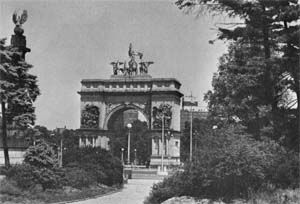 |
| Memorial Arch from East Walk. Photograph, 1965. |
The second and greater structure is Terrace Bridge, which carries the traffic of Hill Drive across the straits connecting the Lake and Lullwater. As its name signifies, Terrace Bridge was meant to be an integral part of the landscaping about the unrealized Refectory. A photograph of the first temporary span here, taken in the early 1870's, shows a rickety open framework of timber. The later permanent bridge of 1890 is substantial, having abutments of brownstone. It has buttresses and bonnets to the piers suggesting forms of Meadowport Arch, and circular plaques on the sides of the stonework inscribed with the date of erection in large numerals. The roadway over the gorge is carried on six steel arches side by side, the outermost enriched with spandrel panels. A parapet the length of the bridge is pierced by a row of little lobed arches.
The scale of Terrace Bridge was prophetic of a grandeur that was to appear at and modify Prospect Park over the next 35 years. During the early 1890's, the Soldiers and Sailors' Monument to Civil War Union forces was erected on Grand Army Plaza. The architectural design was by John H. Duncan, who, a few years before, had designed and built Grant's Tomb on Riverside Drive in New York, and the sculpture by Frederick William MacMonnies (1863-1937), a native of Brooklyn, who had apprenticed to Augustus Saint-Gaudens for four years before going to the École des Beaux-Arts in Paris to complete his studies. Taking the form of a Roman triumphal arch, the monument was abreast of the times by being in the latest Neo-Classic style, then crystallizing in the renowned "White City" -- the exhibition halls of the World's Columbian Exposition held in Chicago in 1892-93.
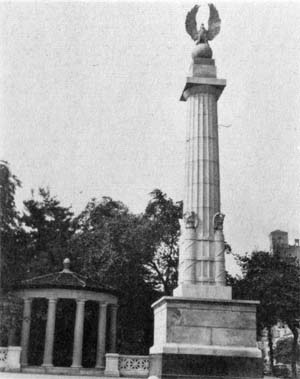 |
| Column and polygonal pavilion, Grand Army Plaza. Photograph, 1965. |
As we have seen, the great elliptical plaza figured in Vaux's sketch of 1865, and it subsequently became the setting for the Lincoln statue and a fountain. The materialization of a triumphal arch with quadriga on top and army and navy groups below was not out of place here, and it was complemented by a pair of Doric shafts, capped with bronze eagles, stationed to either side of the park entrance, also by Duncan and MacMonnies. To further the impressiveness of the Plaza, the architectural firm of McKim, Mead and White was called in to expand the scheme. The three men had served on the Architectural Commission for the World's Columbian Exposition and designed Agricultural Hall and the New York State Building; and, incidentally, they had become associated with MacMonnies and Olmsted at the fair, the sculptor having fashioned the Columbian fountain, and Olmsted having conceived the landscaping. Messrs. Charles Follen McKim (1847-1909) of Pennsylvania, William Rutherford Mead (1846-1928) of Vermont, and Stanford White (1853-1906) of New York set up two more identical pillars, at the Flatbush Avenue and Prospect Park West corners, thus achieving four evenly spaced uprights. They devised curved sections of pierced wall of granite, each ending in pedestals supporting bronze urns, to form a unifying background. Inside the park, near the outer columns, were built two 12-sided pavilions of the Tuscan order, also of granite, containing semicircular benches, and slab screens in six intercolumniations at the back. These pavilions have low-pitched pyramidal roofs capped by bronze finials. The elegant ensemble was completed in 1895. Meanwhile, Frederick MacMonnies had modeled the lifesize bronze figure of James S. T. Stranahan that was installed on a pedestal to the east side of Main Entrance Drive in 1891, honoring the man who had taken the greatest interest in the park, and it is fitting that Mr. Stranahan attended the dedication.
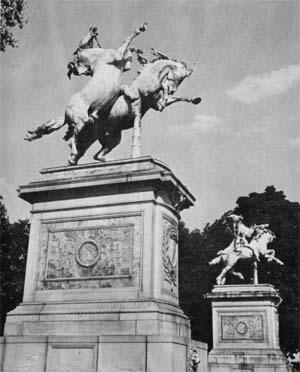 |
| The Horse Tamers, Sculptures at Park Circle Entrance. Photograph, 1965. |
The second most important portal to Prospect Park is on Park Circle, at the south corner, nearest the Lake. The principal motif here is a pair of bronze lifesize equestrian groups, each composed of two horses and a male nude rider, by MacMonnies. Called The Horse Tamers, we are reminded of Coustou's Horses of Marly, the eighteenth century sculptures in the Place de la Concorde, Paris. The horses in Brooklyn are wilder; their ruthless spirit challenges the tamers to remain mounted without benefit of saddles, and the tortured outlines of the forms approach the chaotic. Like the Grand Army Plaza figures, these pieces were modeled in Paris and cast at the LeBlanc-Barbedienne Foundry. The architectural setting on Park Circle again is by McKim, Mead and White, consisting of 19-foot granite pedestals embellished with reliefs in both stone and bronze, walls concentric to the circle interrupted by pedestrian entrances flanked by broad urns, and square end pavilions with corner piers and distyle Greek Ionic columns in antis in each side, covered by low pyramid roofs. The architects proposed four tall granite columns surmounted by bronze eagles to be stationed in back, but these were not included in the 1896-97 construction.
The contemporary Willink Entrance, on Flatbush Avenue near the junction of Ocean Avenue and Empire Boulevard, was named after the family whose old home stood in this vicinity. McKim, Mead and White flanked the drive with twin granite turrets, 20 feet tall, having waist-high bases, plain cylindrical shafts, bonnets enriched with imbrication, and bronze urn finials. Wall segments of base height, with benches set in front of the four sections, terminate at circular sentry boxes, spaced 200 feet apart, and, from these, convex walls curve out to the street. The round boxes originally had hinged doors and glazed windows. They relate to the octagonal granite police kiosks in the park, such as those near the Grand Army Plaza, Park Circle and 3rd Street entrances.
The gateway at 3rd Street and Prospect Park West is guarded by a pair of bronze panthers modeled by Alexander Phinnister Proctor. The sculptured animals were set on tall rectangular granite shafts in 1897.
Perhaps the most inviting entrance is that at the obtuse angle of Parkside and Ocean avenues, also by McKim, Mead and White. A curved granite colonnade of two sections is divided by the driveway, and a walk enters park from the center of each unit. Square end piers are coupled with round Roman Ionic columns, and two pairs of similar columns are between. Screens run along the park side, with benches in front. The colonnades support an open timber trellis clad with wisteria. The curve of the plaza continues beyond Ocean Avenue, forming a half-circle, but does not cross Parkside Avenue. This entrance was realized in 1904.
A companion to this pergola, built by the same designers and at the same time, is the Classic Peristyle, below South Lake Drive and across from the east end of the Parade Ground. It superceded Promenade Drive Shelter, of the late 1860's, a 200 by 35-foot frame structure covered by a canopy and appended to which was a small comfort station. The new pavilion consists of a low platform and a colonnade, with square corner posts and alignments of Corinthian columns between, four in each end and ten on the flank. The supports are of limestone up to the capitals, which, with the entablature, are of whitish terra cotta. Architrave blocks are wedge-shaped, like voussoirs: of a flat arch, and the frieze is filled with a continuous relief of luxuriant foliage. Attic blocks, on axis with the columns, and intervening balustrades surmount the console cornice. The Peristyle sometimes is called the Grecian Shelter, which is a misnomer inasmuch as all of its features are in the Renaissance manner.
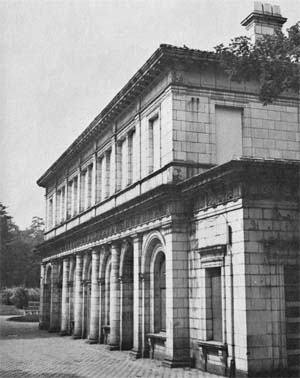 |
| The Boathouse, east facade. Photograph, 1967. |
The monumental gateways opposed the Olmsted-Vaux tradition by introducing architectural features at the entrances, originally elaborated only by rows of evenly spaced trees -- continuous with those of the promenades that encompass the park -- and two small rustic pavilions on the Plaza to serve as shelters for people alighting from or waiting for cars. The McKim, Mead and White gateway additions at least faced out, relating themselves to the city beyond, whereas the Peristyle is wholly inside the park, thus representing a different viewpoint. it was succeeded by three larger structures in the same manner. They were the work of the architectural concern of Helmle, Huberty and Hudswell. Frank J. Helmle (1868-1939) had come from Ohio and studied at Cooper Union and the Brooklyn Museum School of Fine Arts. In 1890 he joined the staff of McKim, Mead and White, and the next year formed a partnership with Ulrich J. Huberty.
Their first building in Prospect Park was the Boathouse, on the east side of the Lullwater. It was built in 1905 to replace the old wood shed boathouse around to the north, at the mouth of the brook. Like the upper parts of the Peristyle, the new Boathouse was built in its entirety of white mat-glazed terra cotta, the roof covered with red tile. An arcade along the water front has engaged Tuscan columns set before the piers, and an entablature with triglyphs is surmounted by a balustrade. The design was borrowed from the lower story of Sansovino's Library of St. Mark, of the sixteenth century, in Venice. The first story originally was open. Double staircases rose from the middle of the building to landings on the east wall, whence twin flights came together at a higher landing and a single flight continued to the second floor inside a semicircular well. The stairs embraced a boat-renting office on the main floor, and there was an enclosed kitchen at the north end, and a soda fountain and ladies' rest room at the south. The second story was a dining hall, served by dumbwaiters in the two east corners. French doors opened onto the balustrated terrace. Twenty bronze lampposts with dolphin motifs are spaced along the broad flights of granite steps descending to the landing and continue around the ends of the building. A flimsy open shed intruded upon the landing terrace in 1915.
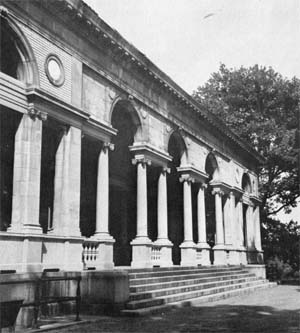 |
| The Tennis House. Photograph, 1965. |
The second Helmle and Huberty building is the Tennis House, constructed in 1909-10 on the west side of Long Meadow, halfway between Swan Boat Lake and the park shops and stables. It provided lockers for participants in the growing sport of lawn tennis, earlier using the basement of the 1885 carousel in Picnic Woods. Built of limestone and yellow brick, on granite foundations, and with terra-cotta vaults and a red tile roof, the Tennis House, like the Boathouse, is classic in style and achieves an intimacy with the park through being predominantly open. The characteristic motif is the triple void, the centermost arched, a favorite with the influential sixteenth century Italian architect, Andrea Palladio, whose name it bears. The casino quality of the Tennis House is not unlike that of the elegant mid-eighteenth-century Palladian Bridue in Prior Park at Bath, England, an entirely fitting accent for a natural landscape, according to high British taste of the period. Only to a slightly lesser degree can the same English monument be compared with the two preceding pavilions in Prospect Park. Although the original designers would not have approved of their existence in this idylic retreat, at least there is basis for a respectable argument to be used in their defense.
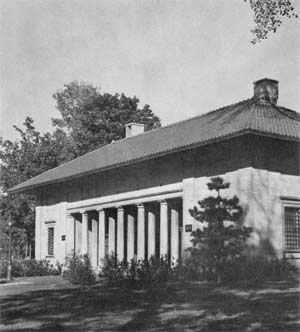 |
| Willink Entrance comfort station. Photograph, 1966. |
The third detached building in Prospect Park by the Helmle firm is the Willink Entrance Comfort Station, built in 1912. Like the Tennis House, it is constructed of limestone and yellow brick and has a red tile roof. Wash rooms at either end are connected by a vaulted breezeway supported on each side by Tuscan columns in five pairs, set one behind the other. Twin chimneys rise hipped roof and deep eaves overhang the Willink Comfort Station is less classical than its forerunners and forecasts the expiration of the the style from Prospect Park. Later buildings, at most, were to show isolated related details, and these not in very good scale with the buildings to which they were attached.
Even during the quarter of a century preceding the First World War, there were improvements put into the park that were in no wise Neo-Classic. Two examples were erected on the Peninsula, and both had a strong flavor of Olmsted-Vaux park architecture about them. The first one was on the south shore, equidistant between the Landing Shelter and Well House. It was the Model Yacht Club House, in which miniature ships were kept for sailing on the Lake. It was a cruciform frame building, with an octagonal superstructure providing clerestory lighting at the crossing. This unostentatious clubbouse was built in 1900, and it burned in 1956, together with its cherished contents. Only the landing terrace in front remains. The miniature-boat enthusiasts were relocated in the abandoned Well House. The second structure was directly across the Peninsula, or midway between the Model Yacht Club House and Terrace Bridge. Here was a low, sprawling shelter with gently sloping roofs and deep overhanging eaves, including a long breezeway between end pavilions, the gables of which jutted through the hipped roof. Despite the difference in roof pitch, the style of the structure related to that of Concert Grove House. Its rustic parts were of cedar and the roofing was of chestnut slabs. Although built 15 years after its companion, the shelter disappeared first. Both are regrettable losses to the park.
During the second decade of the century the stable quadrangle was built between the existing utility-conservatory group and West Drive, on a line with 6th Street. Although the largest structure erected in Prospect Park up to this time, its simple lines, low masses and semi-isolation make it an acceptable addition to the complex. Its brick walls are articulated with arches; a porte-cochere leading into the courtyard and a small belfry lend interest to the design.
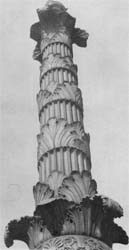 | |  |
| Left: Column detail, Bartel-Pritchard Circle; photograph, 1965. Right: Acanthus column of Delphi. Reconstruction by Theóphile Homolle. (Revue Archéologique, 1917) |
Two fine classic monuments, that will reward our consideration before leaving this era, are located on the west perimeter of the park. The first is at the entrance on Bartel-Pritchard Circle. It consists of a pair of giant pillars of such uniqueness as to be a noteworthy landmark. The source of inspiration was the little-known Acanthus Column of Delphi, a votive shaft dating from the beginning of the fourth century B.C. In using it for a model, Stanford White made the most of its best features and improved its proportions, achieving a more substantial foundation and a less topheavy summit. The result is an exquisite form, which, if one did not know of its antique archetype, one would attribute it to a stroke of genius on the part of a designer of the classic-eclectic period. Set on a high square plinth, each shaft is banded at the base, above which is a campaniform carved with a frieze of Greek anthemion. Four girdles of acanthus leaves alternate with four fluted drums and the whole is crowned by a flaring acanthus capital. A bronze tripod of utmost simplicity is atop the shaft; the sculptured caryatids supporting the urns in the original are eliminated without any suggestion of incompleteness. Stanford White conceived the pillars in 1906, the year he was killed, and one is prompted to look upon the granite uprights as a testimonial to his impeccable artistry.
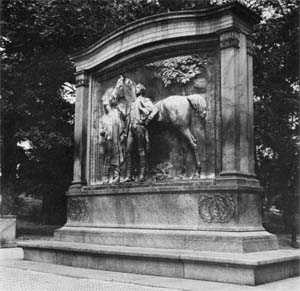 |
| Lafayette Monument. Photograph, 1966. |
Six blocks to the north, facing 9th Street at Prospect Park West, stands the stele honoring the Marquis de Lafayette, French statesman and soldier, who took up the cause of American freedom during the Revolution. The Lafayette Monument presents a lifesize image of the general in the round engaged to a low-relief background representing horse and groom. The bronze plaque was the work of Daniel Chester French (1850-1931), sculptor of the colossal Republic at the Chicago Fair, of the two allegorical figures of New York and Brooklyn from the Manhattan Bridge now at the entrance to the Brooklyn Museum, and later he was to execute the seated marble portrait in the Lincoln Memorial in Washington. His tribute to Lafayette is elevated on a granite podium and enframed by Corinthian pilasters styled after the order of the first-century B.C. Tower of the Winds at Athens. These columns have an unusual capital of a single row of acanthus leaves above which rises a ring of flattened grasses clinging close to the campaniform. The Athenian example has no base, but the pilasters of the Lafayette Monument have normal footings. It was dedicated 10 May 1917; the ceremony included Mme. Louise Homer singing La Marseillaise and The Star-Spangled Banner, accompanied by her husband at a small piano provided for the occasion.
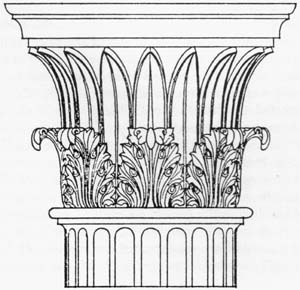 |
| Order of the Tower of the Winds, Athens. Drawing. (Stratton, The Orders of Architecture, Philadelphia, 1931, Pl. XII) |
The United States had been several months at war when the patriotic demonstration was made coincident to the dedication of the Lafayette Monument. As in the Civil War period, little happened in Prospect Park throughout the First World War. The initial addendum afterwards was -- as might be feared -- a memorial to those slain in the service of their country. Called the Honor Roll Memorial, placed by the side of the Lake between Music Island and the Landing Shelter, it features a semicircular granite wall bearing six bronze tablets inscribed with the names of Brooklyn victims of the war. An heroic group in the center represents the winged Angel of Death and the Soldier. A pedestal is in front, seats are to either side, and a circular altar stands in the middle. The shrine was erected in 1920. Arthur D. Pickering was the architect, Augustus Lukeman the sculptor with Daniel Chester French as associate. Although the magnitude and design of the memorial are inoffensive, it is a reminder of the tragic consequences of violence that would have a more sympathetic setting in a cemetery; and it ushered in an era of building in the park in which the basic concepts, in one way or another, were as inappropriate as here and likewise should have sought sanctuary elsewhere.
In 1927 a new and larger Picnic House was built to replace the older one on the same site, on Long Meadow behind Litchfield Villa and just north of the old carousel. The raised-basement type building of red brick has a projecting entrance block with frontal steps between antepodia, a Palladian arch to the recessed entrance set on a pair of insignificant Ionic columns and crowned by a harsh gable. Details are thin and poorly conceived of manufactured stone. Fenestration is oversized, and the hipped roof, covered with red tile, is steep and heavy. A large assembly hall is on the main floor, and rest rooms, utilities and a lunch counter are in the basement. The architect was J. Sarsfield Kennedy. Picnic House now serves as a Golden Age Center. It resembles a rural schoolhouse of the roaring twenties, an awkward, prosaic, cubic pile, which the graceful sweep of Long Meadow could very well do without.
West of the colonnade at the Ocean Avenue Entrance, near Parkside Avenue, stands a severely rectangular little comfort station with the classic divisions of basement, first story and parapet clearly defined. The central portal is higher, with urns set atop corner piers and an arched doorway. Fenestration is restrained. The building has the virtue of being small, and some attempt has been made to relate it in style to the early twentieth-century buildings in the park. The architect was Kennedy, and it was built in 1930.
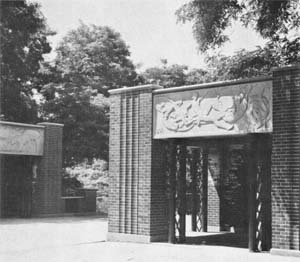 |
| Zoo entrance on Flatbush Avenue. Photograph, 1965. |
Situated north of the Lefferts house on Flatbush Avenue, the Zoo is a group of red brick buildings with limestone trim constructed by Works Progress Administration funds in 1934-35 to replace the menagerie that was in the vicinity of the Dairy, beyond East Drive. The Zoo is entered through open shelters and down curved stairways, with terraces left and right, including a restaurant beyond on the south side and a comfort station on the north. The animal houses form a hemicycle concentric to a semicircular Seal Pool, the domed Elephant Rotunda on axis opposite the entrance, and two bird cages beyond. Bear pits along the Flatbush Avenue side have sunken barrier moats to permit a view of the animals without the obstruction of bars. Bas reliefs on the exterior of buildings illustrate scenes from the adventures of Mowgli, the hero of Kipling's Jungle Books. They were carved by Hunt Diederich, F. G. R. Roth and Emele Siebern. The frieze mural inside the Elephant Rotunda was painted by Allen Saalsberg. The ensemble resembles the zoo in Central Park, which was designed and built earlier by the same architect, Aymar Embury, II; and, although the Zoo in Prospect Park is smaller, it is the better integrated composition -- another instance in which the Brooklyn park benefited from experience gained in the Manhattan preserve, if one can accept the zoo as a benefit to the park.
The first zoo in Central Park had come into existence as an adjunct to the Museum of Natural History, then housed in the Arsenal, and the new zoo was a better organized institution on the same site. The Zoo in Brooklyn was an imitation of the latter, and its advent meant the forfeiting of the Wild Fowl Pond and small east greensward. These were on the site of the original Deer Paddock, described in 1868 as "a bright, sunny little meadow, with sparkling water, lost in the distance under trees . . . set off for the pasturage of deer . . . [and] so arranged that, while the visitor cannot enter it, he will not notice any artificial obstruction." It was explained elsewhere that a delicate iron paling, camouflaged by undergrowth, surrounded the range. As has been noted, Mr. Olmsted had sheep and cattle grazing free on the meadow. He refrained from developing the "Zoological Ground" indicated along the west boundary of the park in the earliest design, saying it would "be placed under the control of a special corporation," and that the subject would "be recurred to." Of course the Litchfield Villa remained in the middle of the designated area and, before the termination of the tenure of the landscape architects, the designation of this spot as a zoological ground had been effaced from the plan. Olmsted could not reconcile the imposed confinement of animals in iron cages with a pleasure garden for human beings seeking escape.
Aymar Embury, II, also designed the Band Shell located off Prospect Park West between 10th and 11th streets. It was built in 1939, and consists of a platform projecting in front of an arching sounding shell of concrete, with lower walls of well laid Flemish-bond red brick, relieved only by copings of cast stone, extending out symmetrically and having shallow recesses to each plane. A half-round paved play-dance area of 125-foot radius forms a forecourt to the building, which is 88 feet across. It contains lockers, dressing and rest rooms for the musicians or performers, public lavatories, park maintenance and supply rooms, and chair storage space tinder the stage. The Band Shell is seldom used, the Goldman Band performing at Music Pagoda near the Lily Pond. The Band Shell is innocent of architectural embellishment and looks as out of place in this simulated rural setting as a colossal overturned piano box of equal dimensions.
The Carousel near Willink Entrance is the fourth of its kind in Prospect Park. The first (1874) was at the Playground and was moved to Picnic Woods to become the second (1885). It was replaced on the same site by the third in 1915, this one designed by Carl T. Berger of Philadelphia and built at a cost of $10,000. The present Carousel was constructed in 1952 for $75,000. Whereas its predecessors were built of wood, the fourth Carousel has banded yellow and red brick walls. It follows their precedent, however, in being octagonal and having hipped roofs, a clerestory here furnished with colored glass. Segmental arched doors have overhead rolling steel shutters. The horses of the merry-go-round came from the old Coney Island carousel of the McCullough brothers. Designed by the staff of the Parks Department at the Arsenal, the carousel building captures the spirit of park architecture better than any of its contemporaries, though a projecting cornice would have given it a more acceptable profile and allowed interesting shadows to play on the walls.
In 1959 the south end of Long Meadow was disfigured by two concrete and brick bleachers, and wire-mesh fences encircling a baseball diamond. The intrusion was inexcusable, showing complete ignorance of the basic purpose of Prospect Park.
An even greater catastrophe befell the park in 1960, with the wrecking of the south side of stately old concert Grove, including filling in the shore line and obliterating Music Stand Island. The desecration was prelude to the formation of a 140-by-200-foot skating rink, surrounded by high metal fences and joined to a squat, sprawling skaters' shelter, with exposed freezing machinery at the northwest corner. The shed is made of zinc alloy, tinted plate glass, cement plaster, anodized aluminum, and brick and precast concrete panels. The structure is what one would expect to find serving as a snack bar on a busy freeway, and its self-conscious geometry and artificial materials could not look more out of place than in this sylvan setting. It was planned by Hopf and Adler and cost $857,000. Nowadays, wandering down into the lower terrace of Concert Grove, one is not only confronted by this unsightly fabrication but offended by loudspeakers blaring forth canned music of the most tawdry sort -- a far cry from the original scene here, of people strolling, sitting on benches, in carriages, in boats, at tables under the oriental shelter, all listening to live music from an orchestra stationed on the island. It seems incredible that Prospect Park, at this late date, could have been considered an undeveloped lot, miraculously left untouched by an expanding metropolis, and therefore in need of being put to some well intentioned use.
Even during the incumbency of the original designers, there had been those who had no concept of the overall purpose and significance of a natural garden and who attempted to blazon their personal interests before the public on park land. Olmsted, writing about such encroacbments attempted in Central Park during the early 1870's warned that if they were not firmly opposed, the result would be the park's "conversion into a great, perpetual metropolitan Fair Ground . . . a desultory collocation of miscellaneous entertainments, tangled together by a series of crooked roads and walks, and richly decorated with flowers and trees, fountains and statuary." As an anecdote for this piecemeal destruction, he issued the following dictum, capitalized for emphasis:
THE ONLY SOLID GROUND OF RESISTANCE TO DANGERS OF THIS CLASS WILL BE FOUND TO REST IN THE CONVICTION THAT THE PARK THROUGHOUT IS A SINGLE WORK OF ART, AND AS SUCH, SUBJECT TO THE PRIMARY LAW OF EVERY WORK OF ART, NAMELY, THAT IT SHALL BE FRAMED UPON A SINGLE, NOBLE MOTIVE, TO WHICH THE DESIGN OF ALL ITS PARTS, IN SOME MORE OR LESS SUBTLE WAY, SHALL BE CONFLUENT AND HELPFUL.
The quotation offers the key to the real distinction between the buildings of the pre-World War I and those of the postwar periods. Let us recapitulate: the Olmsted-Vaux regime lasted from 1866 to 1873, and it was followed by an interim of similar duration sympathetic to the aims of the designers. Then a new viewpoint took hold in the early 1890's and for a quarter of a century the hegemony was held by Classicism. Here we already have two conflicting styles: the first rustic, somewhat quaint, and casual; the second refined, clearcut, and formal. But the fact remains that the individual examples of both have style, they have scale, they serve uses consistent with park purposes, and, most important, each was very carefully designed for perfect harmony with its setting. Constructions built after 1920, by contrast (and here let us make an exception of the Carousel), either have no style at all, or else, as in Picnic House, it seems incidental and like a compromise on a bulky form. Of course there is no intrinsic value to a building's having style. The seventeenth-century imperial Katsura Villa in Japan has none -- in the Western concept of the term -- but it does have exquisite design, excellent craftmanship, and warmth in the choice of materials, making it one of the greatest specimens of architecture in the world, and it accords perfectly with its own contrived rustic landscape environment. But the style-less constructions in Prospect Park are graceless enclosures framed into harsh geometry and discordant with the natural beauty of the place.
Besides, their uses are of dubious character. There is no excuse for having an assembly room, a place of detention for animals, a roofless concert hall, a ball park, or an artificial skating rink within a landscape garden, when all could be located and serve the public equally well outside, and by so doing allow that garden to preserve its verdant identity. The Classic Peristyle, Boathouse and Tennis House send people out to enjoy the natural advantages of the park -- boating, or to play games on the lawn -- and may be looked upon as centrifugal in spirit; whereas Picnic House, the Zoo, the Band Shell, the Baseball Diamond Bleachers and Skating Rink are centripetal, they suck them into their specially conditioned interiors, which are not the park at all but extraneous attractions, and those surrounded by knit-wire fences exclude all but participants. As one might expect, the pouring of money into such illegitimate constructions as these from the 1920's up to 1960 was accompanied by a withdrawing of funds from maintenance, thus allowing deterioration of the grounds and planting gradually to spoil those portions of the park that had escaped defacement by the structures.
There can be no question about it: the great feature of Prospect Park is its varied and well integrated landscape, and no segment of it should ever be isolated for tangential usage, or estranged by disuse, any more than a square of canvas should be cut out or painted over in a great landscape painting. For Prospect Park is no less a masterpiece than a landscape by Kuo Hsi, Pieter Bruegel, or George Inness, and surely no museum or collector owning paintings by these masters would dream of neglecting them or permitting anyone to make changes to them. With no more justification can neglect or incongruous changes be permitted in Prospect Park. As Olmsted said, the park is a "work of art . . . framed upon a single, noble motive, to which the design of all its parts . . . shall be confluent."
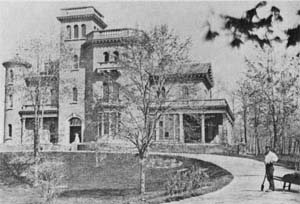 |
| Litchfield Villa. Photograph, 1869. (Long Island Historical Society). |
Prospect Park is host to several important historic monuments never intended to have been in a public garden. The largest is the Litchfield Villa, standing on its present site since some years before the park was proposed. The Viele plan went up to and around the back of the property, but it was included within the boundaries established by Calvert Vaux in 1864. It was originally part of the old Cortelyou estate, purchased in 1852 by Edwin Clark Litchfiield, whose grounds for the residence were bounded by Ninth and Tenth avenues, and 3rd and 5th streets, containing about seven acres. Alexander Jackson Davis, considered the foremost architect of his day, the creator of many of the house designs appearing in the books by the landscape authority Andrew Jackson Downing, mentioned earlier, was given the commission to build a residence that would be a setting suitable to the wealth and social position of the railroad magnate. As was customary on larger commissions such as this, Davis submitted several schemes for the Litchfield house. One filed among the Davis papers in the Metropolitan Museum of Art is castellated and several others are Italianate. All have asymmetrical massing, the Gothic Revival version with Tudor arch at the entrance and battlemented walls, the Italian-villa designs with round arches, towers, balustrades, and low-pitched roofs with overhanging eaves. Litchfield selected a version in the Italian mode.
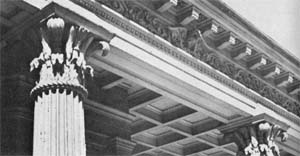 |
| Colonnade detail, Litchfield Villa. Photograph, 1967. |
The Litchfield Villa, completed in 1857, is set on a terrace sustained by a stone retaining wall held together by iron clamps. The main entrance, in the west front, is at the base of a square tower of four stories, adjoining which is a broader, three-storied polygonal pavilion with a flat deck on top, and a curved bay window and balcony at first and third levels. Columned porches are to either side, that on the left encircling the south end of the villa. Cylindrical turrets flank the north end of the composition. The walls are of brick, and they were stuccoed, scored and painted to resemble stonework. Porch supports are an American order featuring corn and wheat motifs on the capitals, recalling Latrobe's corn columns in the senate foyer of the Capitol in Washington. Windows contain diamond-shaped panes bordered by bands of stained glass in patterns.
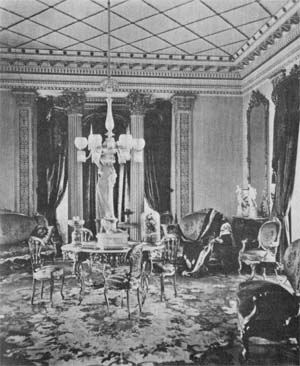 |
| Drawing room or Gold Room, Litchfield Villa. B. J. Smith Photograph, 1873. (New York Genealogical Society) |
The vestibule opens into an octagonal rotunda lighted from above by a circular well. A double staircase rises in the extension to the south, beyond which is the drawing room. Called by the Litchfields the Gold Room, it was furnished and decorated in the Rococo manner. Here one still finds exquisite plasterwork, conspicuously missing elsewhere in the house. Twin Corinthian columns once stood in the recessed bay window. The space flows into conservatories at front and back, actually glazed sections of the encircling piazza. Opening directly off the rotunda and drawing room in front is the octagonal reception room, with a fine caryatid mantelpiece of white marble and lighted by the bow window near the entrance. The small arched windows to either side are modern, replacing earlier niches. The dining room behind is similar in shape and size. Across the vestibule is a circular library lined with cabinets for books, and beyond it a small map room at the base of the northwest turret. Two chambers and conveniences complete the first-story accommodations. It is said that Mrs. Litchfield was a semi-invalid, accounting for the location of the chambers here. She was the former Grace Hill Hubbard and the villa was named after her, Grace Hill, sometimes written by members of the family "Gracehill." Kitchen and store rooms were below stairs, and food was sent up on a dumbwaiter in the service stairball opening off the northeast face of the rotunda.
The second floor of the rotunda has a balustrade around the open well and skylight above. The chamber over the dining room also is skylighted, from the apex of the domed ceiling. A ticket window is in the door, and the Litchfield children used this room as a play theatre. Servants' rooms were in the north wing of the villa, which is three-storied. The room at the top resembles a tiny chapel. A billiard room is on the third floor over the reception-room chamber. It is reached by a stairway in the tower, another flight ascending to roof-terrace level, whence one gets a view equal to that from Lookout Hill. The villa cost $150,000 to build. The grounds were landscaped by H. I. Ehlers of Newport, Rhode Island, constituting the earliest gardening on the park site. Although all the Olmsted-Vaux plans ignore everything bere except the location of the residence itself, it is interesting that the contours of the drive to and around the villa today are as Ehlers planned them. Authority to purchase this and neighboring property to the south was granted by the State Legislature 24 April 1868, but a couple of years elapsed before they were actually acquired, accounting for work progressing along the east side of the park first. West Drive cuts across the northeast corner of the original plot, through the stable site. Notwithstanding the intrusion, the Litchfields continued to reside at Grace Hill on an annual lease from the city of from $3,500 to $2,500 until 1882, the year following Mrs. Litchfield's decease. In 1883 the building became the headquarters of the Park Commissioners, and it has continued to serve primarily for offices to date. A branch library and little theatre have occupied rooms in it briefly. In 1911-13 a dependency was added at the back, connected by an extension to the porch. The architect for this two-storied brick pavilion was Frank J. Helmle.
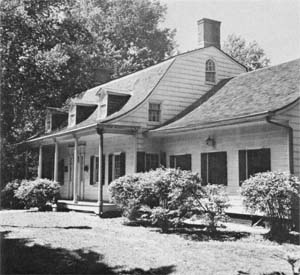 |
| Lefferts House. Photograph, 1965. |
On 13 February 1918 the oldest building in Prospect Park was moved from its original site on the east side of Flatbush Avenue between Maple and Midwood streets and given to the city. The story-and-a-half frame house was set on new foundations facing Flatbush Avenue north of Willink Entrance. It was the home of Lieutenant Peter Lefferts, begun in 1777 to replace his great-grandfather's house, burned by American soldiers under General Sullivan during the preceding summer because it had been captured and was being occupied by the British. The destruction of the old house had occurred on 23 August 1776, three days before the Battle of Long Island. The later residence had acquired an addition at the back and was remodeled inside, but it was restored at the time of its relocation in the park. The building holds great architectural interest, illustrating the final phase of a Dutch type proper to Long Island. The early houses here had steep roofs with end gables, dual-leaf "Dutch" doors and casement windows, like those replaced in the Jan Martense Schenck house (ca. 1675) in the Brooklyn Museum. By the close of the seventeenth century the roof tended to become lower pitched and curved outward at the base, making deep overhanging eaves at front and back. Early in the eighteenth century the double-pitched or gambrel roof appeared, windows became the sash variety and the plan more complex, exemplified in the Nicklaes Schenck house (ca. 1757), also in the Brooklyn Museum. The last stage was the development of the overhangs into porches, with platforms raised off the ground and the roof supported by slender colonnettes. These, the arched dormer windows, clapboard siding, and the doorway with its thin paired supports, carved sunbursts, paneling, and leaded-glass transom and side lights are no longer Dutch but typical features of American Federal architecture.
The plan of the Lefferts House consists of a transverse hall divided by an arch and having the staircase at the rear, with two rooms to either side. The principal interior on the left is united by a wide, curved opening in the partition, stylistically suggesting an early nineteenth-century improvement. There is no fireplace in the rear section, which probably originally was a spare bedroom. The present mantel in the front is a replacement, a mid-nineteenth-century flreplace of marble standing here before the house was moved. Extant plasterwork on the ceiling is of the same period. Chairrailing is conspicuously missing. Adjoining the kitchen wing, this would have been the place for formal dining. The parlor across the hall is more consistent in style. It is encircled by a chairrail, and the rings linking the corners of the bead moldings on the recessed aprons under the windows are repeated around the ceiling. The plaster centerpiece in this room is significant, if it be original. A scallop pattern embraces 16 stars, the obvious interpretation of which is that they represent the number of states existing at the time the work was executed. The sixteenth state was Tennessee, admitted to the Union in 1796, and Ohio was next, admitted in 1803; thus one is led to believe that the Lefferts house was completed within this interim of seven years. It would have been after the decease of Peter Lefferts in 1791, when the property had passed to his second wife, Femmetje Suydam Lefferts. Behind the parlor, but entered only from the hall, is a chamber with a corner fireplace. Most of the chairrailing in this room is not of the period, fragments of the original surviving as window sills. The staircase rises in three flights around an ample well. A groove is cut into the soffit of the stairway for the swinging in of the back door. Upstairs, one should note the sloping vault forms over the dormer windows. There are four bedrooms on the second floor. The back room on the left has a door to the space over the kitchen, where a gangway-type stairs ascends to the garret above the main block of the house. The only upper bedroom with a fireplace is that at the front over the dining room. None of the closets, of course, is original.
The service ell is divided into a number of small rooms as caretaker quarters, and the big cooking fireplace has been bricked up. It is difficult to ascertain the early layout. However, the enclosed stairway by the side of the back door seems authentic, and perhaps the entire area between it and the fireplace constituted one large kitchen. This part of the house may have been built in 1777 and the larger mass constructed -- or at least completed -- later. It is said that use was made of the foundations and some of the lumber and hardware salvaged from the older house after the fire, and indeed a few wroughtiron strap and H hinges and primitive latches on doors in the ell support the tradition. The Lefferts house is furnished with period pieces of the mid-eighteenth to the mid-nineteenth century, a few articles having come from the Lefferts family, such as the big grandfather's clock in the parlor. Since 1920 it has been maintained as a museum by the Fort Greene Chapter of the Daughters of the American Revolution. . . .
South of the Lefferts house and midway between the Willink Entrance and Carousel stands a Flatbush toll booth believed to be the last of its kind in existence. In style it belongs to the middle of the nineteenth century, and it may date from 1854, when what is currently Flatbush Avenue was opened from the Village of Flatbush to Prospect Hill, or, more likely, from 1855, the year of the inception of the Brooklyn, Flatbush and Jamaica Plank Road Company. The pavilion stood on the west side of the pike, between present Winthrop and Fenimore streets, until 1893, when the Flatbush Road Company -- successor to the Plank Road concern -- went out of existence. Given to the last Flatbush Road Commissioner, John Moore, the booth was removed to the backyard of a dwelling at the corner of Tilden Avenue and 28th Street. Some 40 years later, the relic came to the attention of Joseph N. Neff, President of the Chamber of Commerce, through whose efforts it was rescued and presented to the City of New York by the Flatbush Chamber of Commerce. Thus, in 1925, like its historic neighbor seven years earlier, it was given sanctuary in that part of Prospect Park proper to its native township. The Toll House is an octagonal frame structure with vertical-board siding. Alternate faces are pierced by a door and three shuttered windows, and it is crowned by a concave hipped roof with overhanging eaves. The building contains a single room.
In 1932, in celebration of the 200th anniversary of the birth of George Washington, a replica of Mount Vernon, his home on the Potomac, was built on the Peninsula at the base of Lookout Hill. Old photographs reveal that the replica was a faithful copy of the Virginia mansion, as it looked at that time, even to the Chinese-lattice railing atop the portico, later removed in restoration. The architect was Charles K. Bryant and it was constructed by Sears, Roebuck and Company. The lakeside version was taken down after the Washington bicentennial festivities, as it should have been.
With Prospect Park having arrived at its own centennial, our attention focuses on that part of it best adapted to celebrations -- Grand Army Plaza. The first fountain had been installed here in 1871. Its single jet of water must have commanded much attention when there was nothing else on the Plaza but trees and the Lincoln statue; but with the erection of the awesome Soldiers and Sailors' Monument and companion colossal columns and polygonal temples on the south side in the mid 1890's, the older features were reduced to mediocrity. Consequently, the Lincoln figure was transplanted to the center of the lower terrace of Concert Grove in 1895 -- not a very happy move for the Concert Grove -- and the fountain was replaced by a more versatile equivalent in 1897. The new fountain had a center jet encircled by a ring of subsidiaries, and the height and shape of the spurting water could be regulated with precision. Moreover, the aquatic display was illuminated, and illuminated in color. There had been no colored lights at the recent Columbian Exposition at Chicago, nor was a world's fair to employ polychrome lighting until the Pan-American Exposition at Buffalo in 1901, so that a water display with rainbow illumination was a spectacular innovation at that time. The electrical engineer for the Brooklyn fountain was F.W. Darlington of Philadelphia, and the cost was $24,500. The fountain on Grand Army Plaza was undermined by and became a casualty to the subway a little over a decade later. After an empty center for some years, the present Bailey Fountain was built during 1928-32. Eugene Savage was the sculptor of the current group. The two principal bronze figures, a male and female nude, represent wisdom and felicity. This fountain cost $100,000.
Frederick Law Olmsted, then a venerable gentleman of 75, was consulted about the 1897 fountain. He replied that it should not be put inside the park, whereas it was all right to put it in the Plaza, where its predecessor had been. That his advice was sought was a concession to tradition, a most important factor, the following through of which is responsible for the perseverance of so much of the status quo of the park. It was also in 1897 that the people of Brooklyn caused a bandstand to be rebuilt on Music Island, and an orchestra was ferried out to revitalize old Concert Grove with music. The citizenry proceeded to promenade in what they were contemplating renaming the "Italian Gardens" and bask in the nostalgia of past grandeur; but since the recent renovation coeval with the installation of the Lincoln statue, the young London plane trees (now so magnificent!) were sparse and the peripatetics basked mostly in the hot sun. After this, they were content to return to the shade of the woods around Music Pagoda and leave the Flower Garden to thrive quietly in the sun. The music lovers of the gay nineties might have held their concert in the cool of the night, as lamp posts already had begun to appear within the boundaries of the park, although probably only along the principal drives. However, it was not until 1914, due to a surge of vandalism prompting the installation of many additional standards, that the park was considered adequately lighted at night. The lights that were put in, for the most part, are those that exist today, the design of the present handsome cast-iron lamp post by Henry Bacon having been adopted in 1907.
On 20 October 1917 Brooklyn celebrated the 50th anniversary of the opening of Prospect Park, and the ceremony took place at the triumphal arch on Grand Army Plaza. The original event had occurred on 19 October 1867, but inasmuch as the 19th fell on a Friday in 1917, it was decided to hold the commemoration on the following Saturday afternoon at 3:00 o'clock. The nation had been at war over six months, and the festivities were appropriately brief. They were presided over by the President of the Brooklyn Civic Club and consisted of a few short speeches and musical numbers on the solemn side, including a grand march, Prospect Park, which had been composed by Luciano Conterno and dedicated to the Brooklyn Park Department in 1869. A single-sheet program was passed out. Besides the schedule of events it provided a simplified map of the park on the back and a description inside. Among other facts, the text stated that Prospect Park had cost Brooklyn $9,919,370 -- a million more than the total quoted when Olmsted and Vaux terminated their regime here 44 years earlier -- but that the land alone, exclusive of buildings, in 1917 was estimated to be worth $32,000,266. Having in hand a billet giving such satisfying information must have allowed everybody to return home happy, realizing that the city's money had been spent wisely and well. They should have been thankful that the park had been built when it was, and that its designers had been available to create such a masterwork. They also might have been grateful that, up to then, not one major error had been inflicted upon the finest natural landscape garden in America.
In 1966 Prospect Park celebrated its 100th anniversary. Festivities began with a birthday party on June 2nd, a Thursday, chosen as the first convenient day after May 29th, a Sunday, which marked the exact century after Olmsted and Vaux were installed as Landscape Architects of Prospect Park. School children were given an afternoon holiday to attend, and senior citizens were bussed in. A parade assembled on Prospect Park West to march into the main entrance of the park. There were bands, horsedrawn carriages bedecked with flowers, antique automobiles with drivers and passengers in period costumes, high-wheeled and other bicycles, a six-car train, boy and girl scouts and a small troupe of American Indians in tribal dress. They paraded through the park to Music Grove, where presentations and speeches began at 3:00 o'clock from the Music Pagoda. Mr. Robert E. Blum, Chairman of the Prospect Park Centennial Committee, was master of ceremonies and introduced the speakers: the Hon. Abe Stark, Borough President of Brooklyn; the Hon. Robert Moses, Chairman of the Triborough Bridge and Tunnel Authority and for over 30 years New York Parks Commissioner; the Hon. Thomas P. F. Hoving, present Commissioner of Parks; and the Hon. John V. Lindsay, Mayor of the City of New.York. A model of the Centennial Plaque was unveiled. Designed and modeled by sculptor Neil Estern, it is a long panel containing likenesses of Messrs. Olmsted and Vaux in low relief to either side of an inscription ending, "The Park is Their Monument." Music was provided by a military band, Mrs. Morris Kirsch, soloist, and a borough-wide junior High school chorus. A mammoth cake was cut by Miss Prospect Park, pretty Cathy Condon, and slices passed out to the principals on the podium and senior citizens in the audience. Green and yellow balloons bearing the centennial dates were given to youngsters and souvenir brochures to adults. The event opened a summer of activities including concerts of jazz and classical music, opera and dramatic presentations, ballet, folk and square dancing, art shows, story hours for children, and guided tours through the park.
At the time of its centennial, despite superficial sprucing up, Prospect Park looked much the worst for wear, in comparison to its appearance at the quieter celebration 50 years earlier. Neglect and ill-advised encroachments inflicted upon it since the surcease of the Brooklyn Park Commissioners and the centering of this office in Manhattan in 1934 were everywhere in evidence. But, to counteract these destructive forces, a group of enthusiasts stepped forward in 1966 and banded together as the ,a href="http://www.greenswardparks.org">Friends of Prospect Park. They are dedicated to the proposition that Prospect Park is the foremost art monument of Brooklyn, that it was designed for, approved by and belongs to the people of this city, that it is an important part of their heritage and, as such, it should be passed on to future generations unspoiled by inappropriate modifications. The nearby Brooklyn Museum, Botanic Garden and Public Library were planned as integral institutions, and to redirect the course of any one of these would be a stab at the vital heart of Brooklyn. They must remain functioning each in its own special way and all together as an organic unit. The vision that is necessary was expressed by the Hon. Robert Moses in his centennial address.
Glancing backward he said:
. . . the integrity of the Olmsted design of Prospect Park was faithfully, almost religiously adhered to by a succession of [Brooklyn] Commissioners, like my friend Raymond Ingersoll who is buried here in the Quaker Cemetery on the ridge.
And looking forward he declared:
This Park, under pressure of the millions, faced with disorder, destructiveness and defiance of authority which seems worldwide and inexplicable, needs more than a mere face lifting. It requires expensive, wholesale restoration and then better maintenance and more policing.
He decried the attitude of those who vandalize parks and voiced the hope that:
. . . the second century will repair the wear and tear of the first and serve increasingly the demands of the people.
Finally, he expressed the sentiments of all who hold the park dear:
Prospect Park is the immediate jewel of Brooklyn's crown. Let it shine on forever.
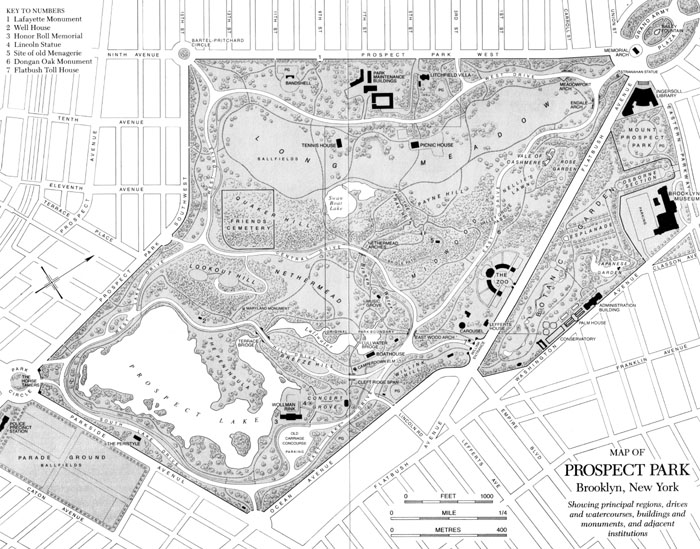
George Colbert and Guenther Vollath
GLOSSARY
Acanthus. A Mediterranean plant of which the spiny leaves served as model for classical decorative motifs, as on the capital of the Corinthian order
Antepodia. Projections in front of the podium, or basement, as cubic forms flanking a stairway
Anthemion. A stylized pattern based on the palmette or lotus flower used in classic relief decorations
Architrave. The lowest of three members of an entablature; a horizontal lintel carried from the top of one column or pier to another
Balustrade (Latin balaustrium: a pomegranate). A series of upright forms supporting a railing
Bargeboard. The decorated raking board of an overhanging gable
Batter. To slope inward
Bay. Any architectural unit or division
Bead molding. A small half-round strip
Bonnet. A false dome or rounded roof or superstructure
Casino (Italian: little house). A building for amusement and recreation
Chairrail. A wood molding affixed to the wall of a room at the height of the back of a chair for protecting the plaster
Clerestory. A row of windows high in a wall
Colonnette. A small, slender column
Console. A bracket of classical form, usually scrolled at top and bottom
Corinthian. The classic order with a campaniform capital decorated with acanthus leaves and volutes, supposedly originated at Corinth
Cresting. An openwork ornament along the horizontal ridge of a roof, usually metal
Cupola. A polygonal superstructure at the peak of a roof with windows in the sides; also called a lantern
Distyle. Having two columns
Doric. The common Greek order, distinguished by a heavy column without base, having a channeled shaft and capital made up of an echinus and square abacus; this type was developed in the Dorian or western region of Greece
Ell. A wing or extension at the side or rear of a building
Entablature. The horizontal part of an architectural order, supported on columns or piers, normally composed of architrave, frieze and cornice
Extrados. The outer edge of an arch
Federal. The neo-classic style of the late eighteenth and early nineteenth century in the United States
Flemish-bond brickwork. A wall composed of alternating bricks laid sidewise and endwise, creating a checkerboard-like pattern
Frieze. The middle section of the entablature, usually embellished with reliefs; any banded division painted or carved
Gambrel roof. A curb or double-pitched roof of which the lower plane is more steeply pitched
Gothic revival. The nineteenth-century romantic style inspired by English and European monuments of the late medieval period
Hipped roof. A roof in which the sloping planes come together at the corners (hips), as opposed to one with gables
Imbrication. An overlapping fish-scale motif, as of shingles
in antis. Referring to supports stationed between antae, or piers
Ionic. The classic order distinguished by volutes on the capital, come from Ionia, Asia Minor
Kiosk (Turkish kiushk: pavilion). An open summerhouse
Lintel. The horizontal beam or member bridging two vertical supports
Mogul. The Mongol rulers of India (1526-1857) or pertaining to the style of that period
Neo-classic. The revived phase of the classical contemporary with the World's Columbian Exposition at Chicago, 1892-93
Pagoda (Chinese pa-chiao-t'a: eight-cornered tower). An oriental tower
Palladian. Pertaining to the sixteenth-century Italian architect Andrea Palladio; an opening of three parts, the centermost arched
Pergola. An arbor with posts and horizontal trelliswork above, upon which vines are trained
Peristyle. A range of columns surrounding a building or court
Plinth. A square block at the base of a column
Porte-cochere. A carriage entrance leading through a section of a building into an open courtyard
Quadriga. A two-wheeled chariot drawn by four horses harnessed abreast
"Queen Anne" style. A late nineteenth-century revival of the early Renaissance mode of Queen Anne's reign (1702-14), popularized by the English architect Norman Shaw
Quoin. A projecting block at the corner of a building used decoratively
Rides. In the early days used to refer to the bridle paths in Prospect Park
Rotunda. A round or polygonal building or large ball usually crowned by a dome
Saracenic. The name Saracen was applied by the ancients to the nomadic tribes on the Syrian borders of the Roman Empire, and the adjective came to be a general term for the Moslem style during the time of the Crusades
Segmental arch. A less-than-full arch, one meeting the side supports in angles
Soffit. The under side of a doorway or window lintel, or of a staircase
Spandrel. The triangular space between the curve of an arch and its rectangular enframement
Stele. An upright slab or pillar bearing an image or inscription
Transom. A window over a door
Trefoil. A three-lobed ornamental gothic motif
Triglyphs (Greek: three channels). Blocks with vertical grooves, alternating with reliefs in the frieze of the Doric entablature
Tudor arch. A low-pitched pointed arch in the late gothic manner
Tuscan. The Roman Doric order, in which the column is more slender than in the Greek, having a base and smooth shaft
Vault. An arched ceiling
Vertical-board siding. A wall composed of adjacent, flush, upright boards, the joints of which are covered with narrow strips of wood
Votive. Pertaining to an offering or dedication
Voussoir. A wedge-shaped stone composing an arch
A WORD FROM THE AUTHOR, CLAY LANCASTER, THIRTY YEARS LATER
I fell in love with English natural landscape gardens while studying at the University of Kentucky during the late 1930s. I came to live in New York City in 1943, and first encountered Frederick Law Olmsted and Calvert Vaux when I was asked to write an essay on Central Park for the April 1951 issue of Magazine of Art. During the course of this project, I moved from the Columbia University area, where I was living, to Brooklyn Heights. Weekend hikes that I used to make by various routes through Manhattan to Chinatown or Battery Park now shifted to the Brooklyn Botanic Garden, Brooklyn Museum, the Public Library at Grand Army Plaza, and Prospect Park for destination. I had already become enamored of the Park when Tom Hoving, the new Parks Commissioner under Mayor John Lindsay, asked me to assume curatorship of Prospect Park in January 1966.
Prospect Park Handbook was published by Greensward Foundation in November 1967. It came out in two editions. One was a limited printing of which copies were autographed by me and by the poet Marianne Moore, who had written the foreword. Both editions were hardbound books. A paperback reprint was issued in October 1972 containing an essay by M. M. Graff on "Remembering Marianne Moore." A later paperback edition, with a new cover, was released in August 1989. As of that date, I had been residing for nearly ten years in an early-nineteenth century house by a ravine on the Kentucky River.
I have my own natural landscape that extends along the road overlooking the river one mile, and up the tributary called Landing Run a half mile. (James Harrod and party ascended Landing Run in 1774 when they founded Harrodsburg, the first permanent settlement in Kentucky.) Here, wildflowers flourish throughout the warm months, becoming spectacular in late April and early May, and the woodland shelters deer and other forest creatures, (I abhor the term "wildlife," as if all non-domesticated animals were fierce predators), that roam free.
After serving as curator of what is generally adjudged to be America's finest natural landscape urban park, I now find myself steward of a natural landscape preserve that I consider unsurpassed. The Chinese painter Kuo Hsi's remark about "a virtuous man [who will] take delight in landscapes", quoted at the beginning of Prospect Park Handbook, takes on new meaning when one resides in a choice spot, just as it does for a city dweller entering a great park created by Olmsted and Vaux.
March 21, 1997
Clay Lancaster
Warwick Foundation
Salvisa, Kentucky
REMEMBERING MARIANNE MOORE
Marianne Moore's active championship of the cause of park preservation began in 1964 with the fight to save Brooklyn's most beloved landmark, the Boat House in Prospect Park. This elegant and functional building was once the center of Prospect Park's most popular activities, boating and ice skating. Lack of maintenance had reduced it to a shabby ruin, boarded up and left to decay.
The decision to pull down the Boat House was not discovered until the contracts for demolition were ready for signing. When the story broke, it roused a storm of public protest. Among other prominent spokesmen for Brooklyn, Miss Moore wrote an appeal to save the Boat House: "I implore Mr. Newbold Morris to allow our Boat House in Prospect Park to remain. We in Brooklyn admire it. No substitute for it would appease us. October 24, 1964." To follow up her letter, Miss Moore appeared at a City Hall hearing to plead for restoration of the Boat House and for adequate funds to maintain Prospect Park.
A small group of civic leaders and park enthusiasts, inspired by the approach of Prospect Park's centennial in 1966, had worked individually through tours and lectures to arouse public appreciation of the unique beauties of the park and of its need of restoration. In 1964, these men and women joined forces by creating Greensward Foundation, named for the prize-winning design for Central Park.
Miss Moore was the first president of Greensward Foundation, a post she termed "my only mortal entanglement." In her letter of acceptance, she wrote: "Ingenious to name me president of the Greensward Foundation and deliver a package of stationery (I assume as an expedient to insure my attendance at meetings). This present almost makes me feel like an official. It won't do. Please append 'By Courtesy' to the title 'President' accorded me.
"Pleasing, the name Greensward, to anyone who found as many four leaf clovers as I have."
The threat to the Boat House served to focus public interest on Prospect Park. In order to satisfy the demand for information, the members of Greensward sponsored two groups in 1965: the Friends of Prospect Park headed by Clay Lancaster and, later in the year, the Friends of Central Park under the leadership of Henry Hope Reed. Beginning in 1966, the two architectual historians conducted scheduled tours of the parks, speaking on their history, design, architecture and landscaping.
One of the chief treasures of Prospect Park is the Camperdown elm, a gift of Mr. A.G. Burgess of East New York, planted near the Boat House in 1872. On one of the walking tours of the park, it was discovered that the trunk and massive horizontal limbs were hollow and the tree in imminent danger of collapse. The Friends resolved to save the tree and sent an appeal to members for funds to provide skilled professional care. Miss Moore, who wrote "I could not be more enthusiastic, to name the tree rescue program after the famed Camperdown elm," became its most ardent champion. Her poem "The Camperdown Elm" in The New Yorker and her plea for "our crowning curio" in The New York Times brought the tree wide renown and funds to help save its life.
Miss Moore's final gift to the parks was her request to send contributions to the Camperdown Fund instead of flowers. One of the donors, in a note accompanying her gift, speaks for all the Friends: "In loving memory of Marianne Moore. Enclosed is my donation towards a very beautiful request." The gifts form the nucleus of the Marianne Moore Remembrance Fund whose proceeds will be used to restore a tree each year in joyful memory of her life and work.
M. M. Graff, Director
Camperdown Fund
Brooklyn, New York
 |
| Top of page |
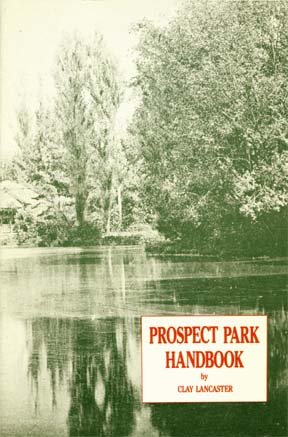 Prospect Park Handbook
Prospect Park Handbook








































